Comparative Analysis of Mercedes’s Competitive Position
VerifiedAdded on 2023/06/10
|25
|8640
|277
AI Summary
This report provides a comparative analysis of Mercedes Benz's competitive position through internal and external analysis. It covers the resource-based value, PEST and five force analysis, and the social impact considered by the company. The report also discusses ethical considerations, code of conduct, and needs of stakeholders. Academic theories are also included in the report.
Contribute Materials
Your contribution can guide someone’s learning journey. Share your
documents today.
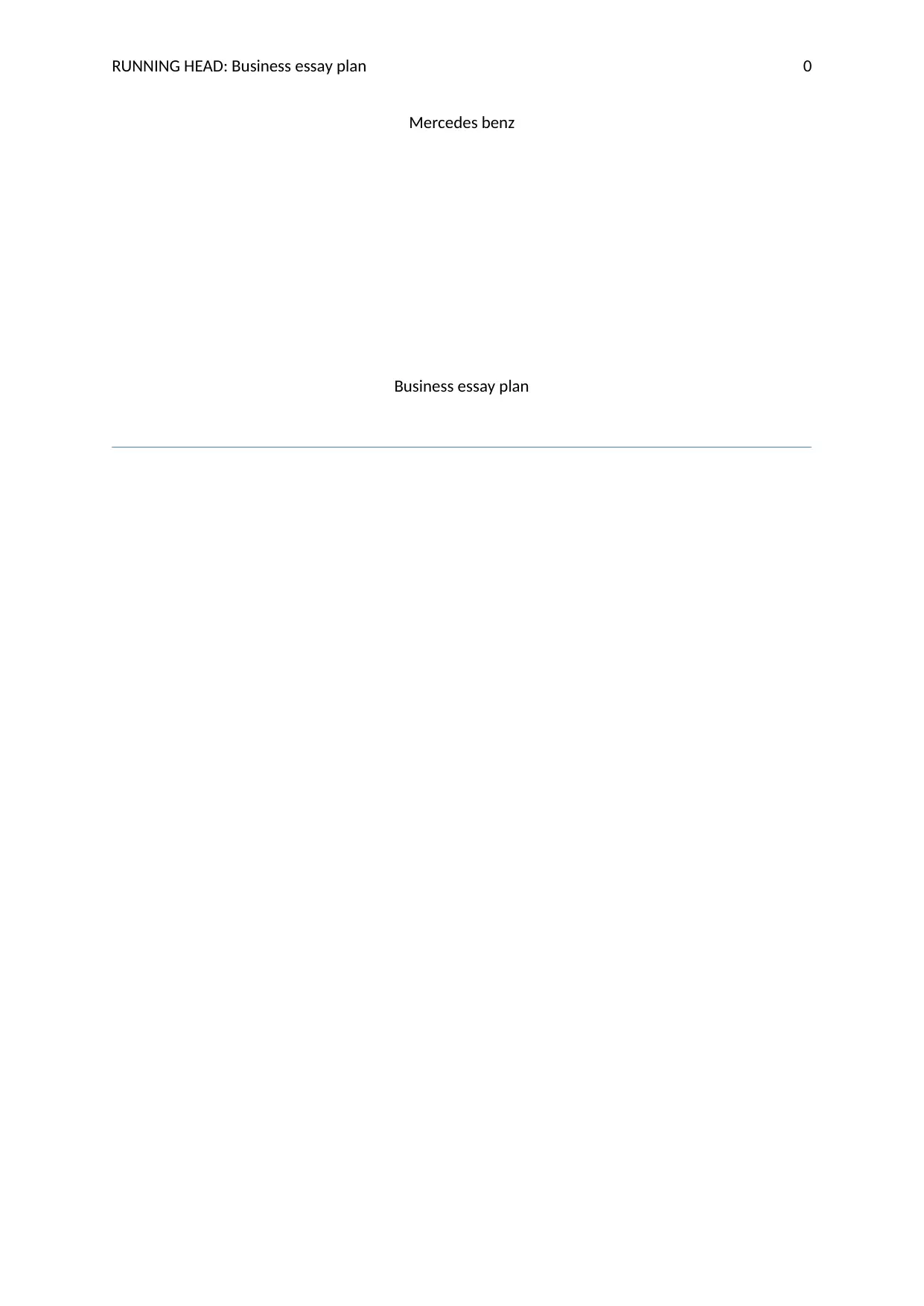
RUNNING HEAD: Business essay plan 0
Mercedes benz
Business essay plan
Mercedes benz
Business essay plan
Secure Best Marks with AI Grader
Need help grading? Try our AI Grader for instant feedback on your assignments.

Business essay plan
1
Contents
Introduction................................................................................................................................2
Comparative analysis of Mercedes’s competitive position........................................................3
Internal analysis......................................................................................................................3
External Analysis....................................................................................................................5
Considerations by the companies to create social impact........................................................10
Ethical considerations...........................................................................................................10
Code of conduct....................................................................................................................12
Needs of stakeholders...........................................................................................................13
Academic theories....................................................................................................................15
Conclusion................................................................................................................................17
References................................................................................................................................19
1
Contents
Introduction................................................................................................................................2
Comparative analysis of Mercedes’s competitive position........................................................3
Internal analysis......................................................................................................................3
External Analysis....................................................................................................................5
Considerations by the companies to create social impact........................................................10
Ethical considerations...........................................................................................................10
Code of conduct....................................................................................................................12
Needs of stakeholders...........................................................................................................13
Academic theories....................................................................................................................15
Conclusion................................................................................................................................17
References................................................................................................................................19
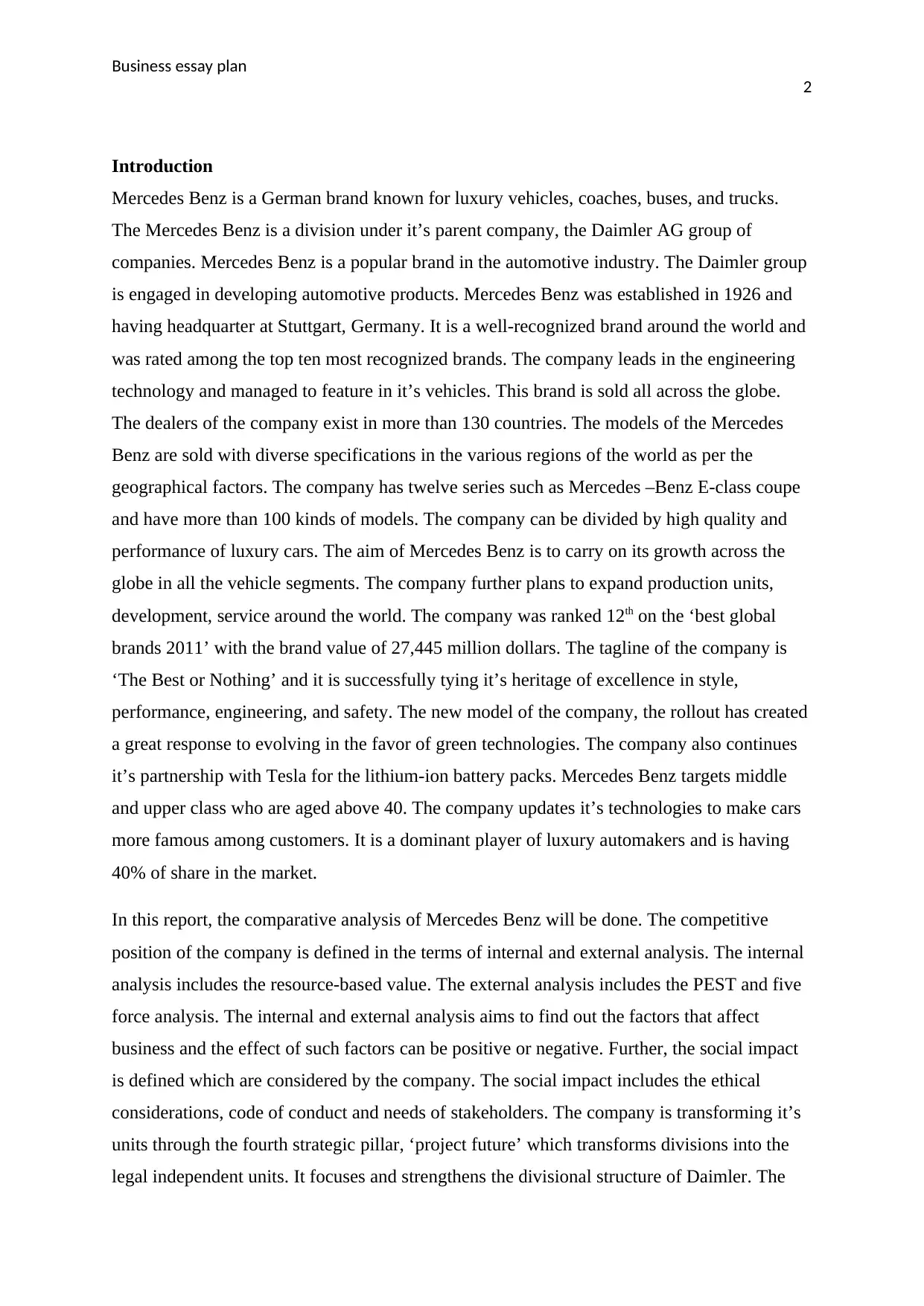
Business essay plan
2
Introduction
Mercedes Benz is a German brand known for luxury vehicles, coaches, buses, and trucks.
The Mercedes Benz is a division under it’s parent company, the Daimler AG group of
companies. Mercedes Benz is a popular brand in the automotive industry. The Daimler group
is engaged in developing automotive products. Mercedes Benz was established in 1926 and
having headquarter at Stuttgart, Germany. It is a well-recognized brand around the world and
was rated among the top ten most recognized brands. The company leads in the engineering
technology and managed to feature in it’s vehicles. This brand is sold all across the globe.
The dealers of the company exist in more than 130 countries. The models of the Mercedes
Benz are sold with diverse specifications in the various regions of the world as per the
geographical factors. The company has twelve series such as Mercedes –Benz E-class coupe
and have more than 100 kinds of models. The company can be divided by high quality and
performance of luxury cars. The aim of Mercedes Benz is to carry on its growth across the
globe in all the vehicle segments. The company further plans to expand production units,
development, service around the world. The company was ranked 12th on the ‘best global
brands 2011’ with the brand value of 27,445 million dollars. The tagline of the company is
‘The Best or Nothing’ and it is successfully tying it’s heritage of excellence in style,
performance, engineering, and safety. The new model of the company, the rollout has created
a great response to evolving in the favor of green technologies. The company also continues
it’s partnership with Tesla for the lithium-ion battery packs. Mercedes Benz targets middle
and upper class who are aged above 40. The company updates it’s technologies to make cars
more famous among customers. It is a dominant player of luxury automakers and is having
40% of share in the market.
In this report, the comparative analysis of Mercedes Benz will be done. The competitive
position of the company is defined in the terms of internal and external analysis. The internal
analysis includes the resource-based value. The external analysis includes the PEST and five
force analysis. The internal and external analysis aims to find out the factors that affect
business and the effect of such factors can be positive or negative. Further, the social impact
is defined which are considered by the company. The social impact includes the ethical
considerations, code of conduct and needs of stakeholders. The company is transforming it’s
units through the fourth strategic pillar, ‘project future’ which transforms divisions into the
legal independent units. It focuses and strengthens the divisional structure of Daimler. The
2
Introduction
Mercedes Benz is a German brand known for luxury vehicles, coaches, buses, and trucks.
The Mercedes Benz is a division under it’s parent company, the Daimler AG group of
companies. Mercedes Benz is a popular brand in the automotive industry. The Daimler group
is engaged in developing automotive products. Mercedes Benz was established in 1926 and
having headquarter at Stuttgart, Germany. It is a well-recognized brand around the world and
was rated among the top ten most recognized brands. The company leads in the engineering
technology and managed to feature in it’s vehicles. This brand is sold all across the globe.
The dealers of the company exist in more than 130 countries. The models of the Mercedes
Benz are sold with diverse specifications in the various regions of the world as per the
geographical factors. The company has twelve series such as Mercedes –Benz E-class coupe
and have more than 100 kinds of models. The company can be divided by high quality and
performance of luxury cars. The aim of Mercedes Benz is to carry on its growth across the
globe in all the vehicle segments. The company further plans to expand production units,
development, service around the world. The company was ranked 12th on the ‘best global
brands 2011’ with the brand value of 27,445 million dollars. The tagline of the company is
‘The Best or Nothing’ and it is successfully tying it’s heritage of excellence in style,
performance, engineering, and safety. The new model of the company, the rollout has created
a great response to evolving in the favor of green technologies. The company also continues
it’s partnership with Tesla for the lithium-ion battery packs. Mercedes Benz targets middle
and upper class who are aged above 40. The company updates it’s technologies to make cars
more famous among customers. It is a dominant player of luxury automakers and is having
40% of share in the market.
In this report, the comparative analysis of Mercedes Benz will be done. The competitive
position of the company is defined in the terms of internal and external analysis. The internal
analysis includes the resource-based value. The external analysis includes the PEST and five
force analysis. The internal and external analysis aims to find out the factors that affect
business and the effect of such factors can be positive or negative. Further, the social impact
is defined which are considered by the company. The social impact includes the ethical
considerations, code of conduct and needs of stakeholders. The company is transforming it’s
units through the fourth strategic pillar, ‘project future’ which transforms divisions into the
legal independent units. It focuses and strengthens the divisional structure of Daimler. The
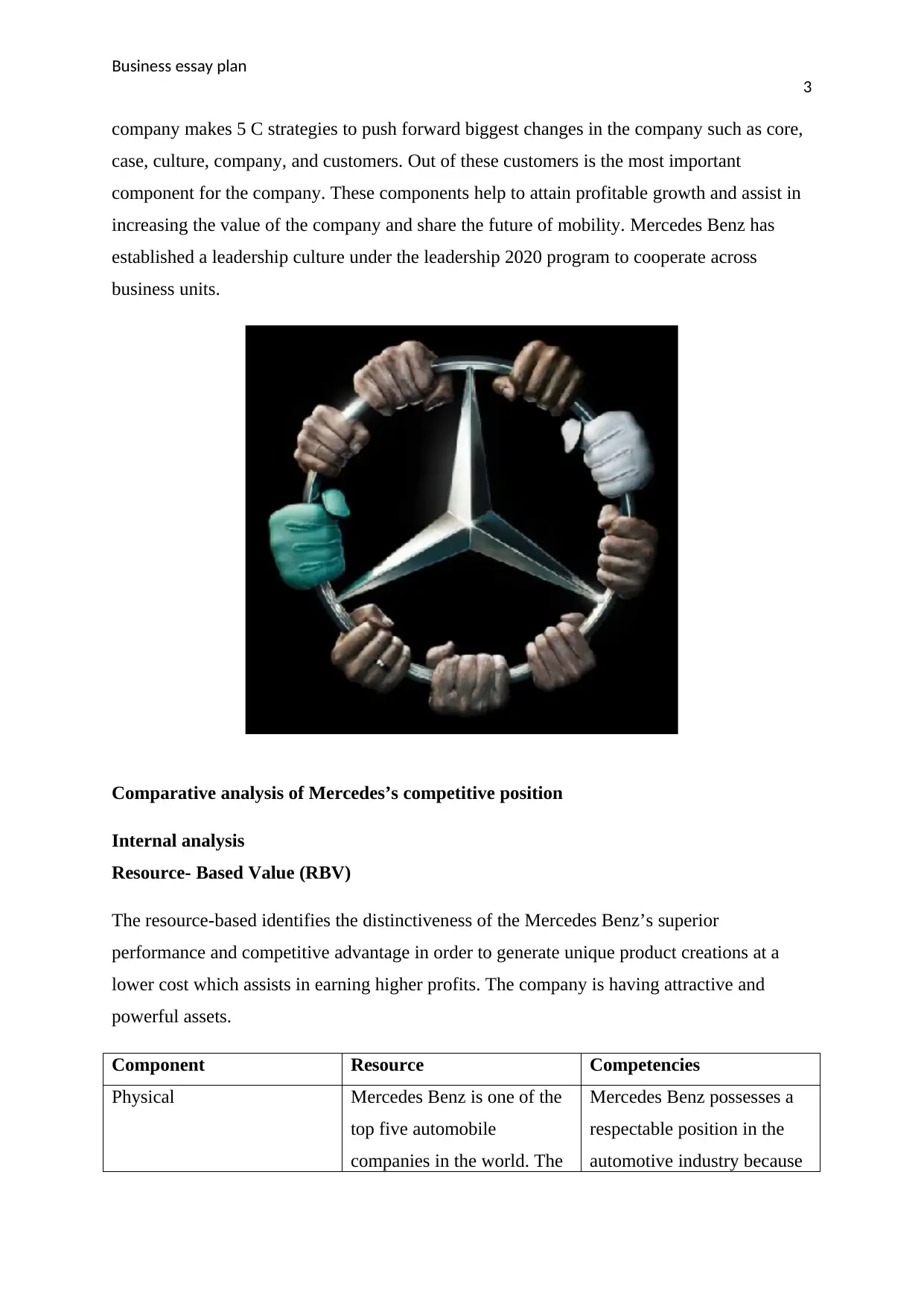
Business essay plan
3
company makes 5 C strategies to push forward biggest changes in the company such as core,
case, culture, company, and customers. Out of these customers is the most important
component for the company. These components help to attain profitable growth and assist in
increasing the value of the company and share the future of mobility. Mercedes Benz has
established a leadership culture under the leadership 2020 program to cooperate across
business units.
Comparative analysis of Mercedes’s competitive position
Internal analysis
Resource- Based Value (RBV)
The resource-based identifies the distinctiveness of the Mercedes Benz’s superior
performance and competitive advantage in order to generate unique product creations at a
lower cost which assists in earning higher profits. The company is having attractive and
powerful assets.
Component Resource Competencies
Physical Mercedes Benz is one of the
top five automobile
companies in the world. The
Mercedes Benz possesses a
respectable position in the
automotive industry because
3
company makes 5 C strategies to push forward biggest changes in the company such as core,
case, culture, company, and customers. Out of these customers is the most important
component for the company. These components help to attain profitable growth and assist in
increasing the value of the company and share the future of mobility. Mercedes Benz has
established a leadership culture under the leadership 2020 program to cooperate across
business units.
Comparative analysis of Mercedes’s competitive position
Internal analysis
Resource- Based Value (RBV)
The resource-based identifies the distinctiveness of the Mercedes Benz’s superior
performance and competitive advantage in order to generate unique product creations at a
lower cost which assists in earning higher profits. The company is having attractive and
powerful assets.
Component Resource Competencies
Physical Mercedes Benz is one of the
top five automobile
companies in the world. The
Mercedes Benz possesses a
respectable position in the
automotive industry because
Secure Best Marks with AI Grader
Need help grading? Try our AI Grader for instant feedback on your assignments.
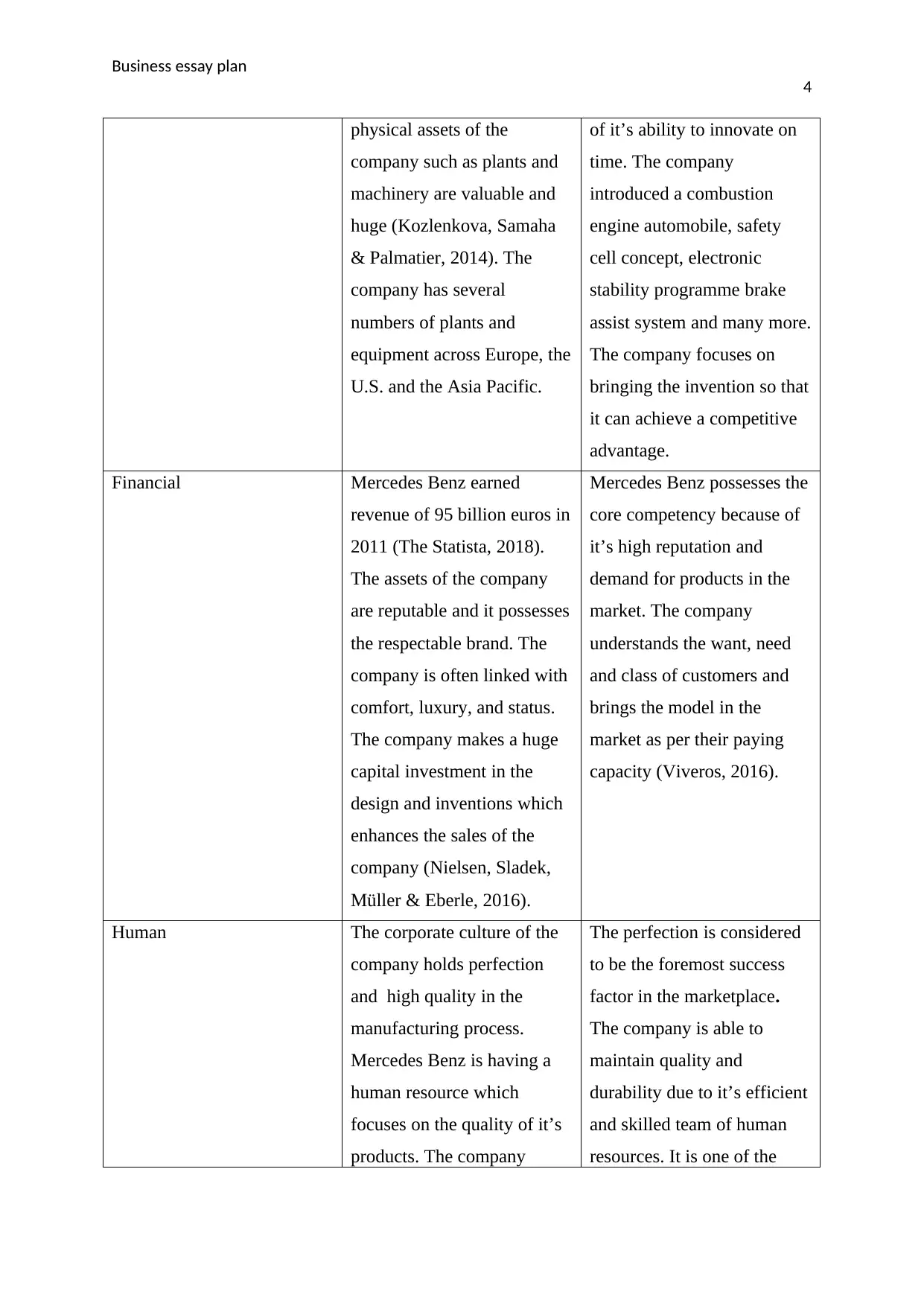
Business essay plan
4
physical assets of the
company such as plants and
machinery are valuable and
huge (Kozlenkova, Samaha
& Palmatier, 2014). The
company has several
numbers of plants and
equipment across Europe, the
U.S. and the Asia Pacific.
of it’s ability to innovate on
time. The company
introduced a combustion
engine automobile, safety
cell concept, electronic
stability programme brake
assist system and many more.
The company focuses on
bringing the invention so that
it can achieve a competitive
advantage.
Financial Mercedes Benz earned
revenue of 95 billion euros in
2011 (The Statista, 2018).
The assets of the company
are reputable and it possesses
the respectable brand. The
company is often linked with
comfort, luxury, and status.
The company makes a huge
capital investment in the
design and inventions which
enhances the sales of the
company (Nielsen, Sladek,
Müller & Eberle, 2016).
Mercedes Benz possesses the
core competency because of
it’s high reputation and
demand for products in the
market. The company
understands the want, need
and class of customers and
brings the model in the
market as per their paying
capacity (Viveros, 2016).
Human The corporate culture of the
company holds perfection
and high quality in the
manufacturing process.
Mercedes Benz is having a
human resource which
focuses on the quality of it’s
products. The company
The perfection is considered
to be the foremost success
factor in the marketplace.
The company is able to
maintain quality and
durability due to it’s efficient
and skilled team of human
resources. It is one of the
4
physical assets of the
company such as plants and
machinery are valuable and
huge (Kozlenkova, Samaha
& Palmatier, 2014). The
company has several
numbers of plants and
equipment across Europe, the
U.S. and the Asia Pacific.
of it’s ability to innovate on
time. The company
introduced a combustion
engine automobile, safety
cell concept, electronic
stability programme brake
assist system and many more.
The company focuses on
bringing the invention so that
it can achieve a competitive
advantage.
Financial Mercedes Benz earned
revenue of 95 billion euros in
2011 (The Statista, 2018).
The assets of the company
are reputable and it possesses
the respectable brand. The
company is often linked with
comfort, luxury, and status.
The company makes a huge
capital investment in the
design and inventions which
enhances the sales of the
company (Nielsen, Sladek,
Müller & Eberle, 2016).
Mercedes Benz possesses the
core competency because of
it’s high reputation and
demand for products in the
market. The company
understands the want, need
and class of customers and
brings the model in the
market as per their paying
capacity (Viveros, 2016).
Human The corporate culture of the
company holds perfection
and high quality in the
manufacturing process.
Mercedes Benz is having a
human resource which
focuses on the quality of it’s
products. The company
The perfection is considered
to be the foremost success
factor in the marketplace.
The company is able to
maintain quality and
durability due to it’s efficient
and skilled team of human
resources. It is one of the
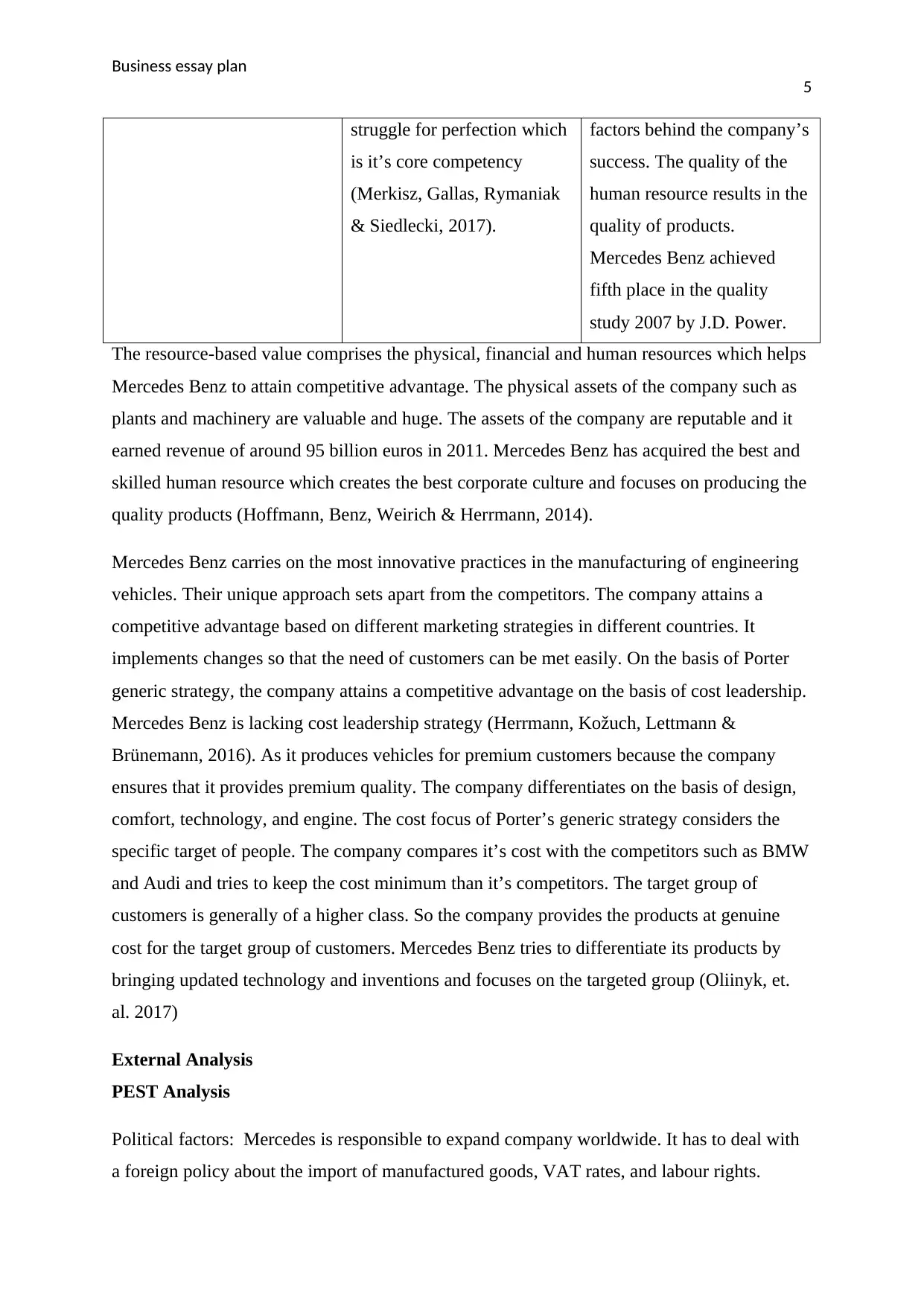
Business essay plan
5
struggle for perfection which
is it’s core competency
(Merkisz, Gallas, Rymaniak
& Siedlecki, 2017).
factors behind the company’s
success. The quality of the
human resource results in the
quality of products.
Mercedes Benz achieved
fifth place in the quality
study 2007 by J.D. Power.
The resource-based value comprises the physical, financial and human resources which helps
Mercedes Benz to attain competitive advantage. The physical assets of the company such as
plants and machinery are valuable and huge. The assets of the company are reputable and it
earned revenue of around 95 billion euros in 2011. Mercedes Benz has acquired the best and
skilled human resource which creates the best corporate culture and focuses on producing the
quality products (Hoffmann, Benz, Weirich & Herrmann, 2014).
Mercedes Benz carries on the most innovative practices in the manufacturing of engineering
vehicles. Their unique approach sets apart from the competitors. The company attains a
competitive advantage based on different marketing strategies in different countries. It
implements changes so that the need of customers can be met easily. On the basis of Porter
generic strategy, the company attains a competitive advantage on the basis of cost leadership.
Mercedes Benz is lacking cost leadership strategy (Herrmann, Kožuch, Lettmann &
Brünemann, 2016). As it produces vehicles for premium customers because the company
ensures that it provides premium quality. The company differentiates on the basis of design,
comfort, technology, and engine. The cost focus of Porter’s generic strategy considers the
specific target of people. The company compares it’s cost with the competitors such as BMW
and Audi and tries to keep the cost minimum than it’s competitors. The target group of
customers is generally of a higher class. So the company provides the products at genuine
cost for the target group of customers. Mercedes Benz tries to differentiate its products by
bringing updated technology and inventions and focuses on the targeted group (Oliinyk, et.
al. 2017)
External Analysis
PEST Analysis
Political factors: Mercedes is responsible to expand company worldwide. It has to deal with
a foreign policy about the import of manufactured goods, VAT rates, and labour rights.
5
struggle for perfection which
is it’s core competency
(Merkisz, Gallas, Rymaniak
& Siedlecki, 2017).
factors behind the company’s
success. The quality of the
human resource results in the
quality of products.
Mercedes Benz achieved
fifth place in the quality
study 2007 by J.D. Power.
The resource-based value comprises the physical, financial and human resources which helps
Mercedes Benz to attain competitive advantage. The physical assets of the company such as
plants and machinery are valuable and huge. The assets of the company are reputable and it
earned revenue of around 95 billion euros in 2011. Mercedes Benz has acquired the best and
skilled human resource which creates the best corporate culture and focuses on producing the
quality products (Hoffmann, Benz, Weirich & Herrmann, 2014).
Mercedes Benz carries on the most innovative practices in the manufacturing of engineering
vehicles. Their unique approach sets apart from the competitors. The company attains a
competitive advantage based on different marketing strategies in different countries. It
implements changes so that the need of customers can be met easily. On the basis of Porter
generic strategy, the company attains a competitive advantage on the basis of cost leadership.
Mercedes Benz is lacking cost leadership strategy (Herrmann, Kožuch, Lettmann &
Brünemann, 2016). As it produces vehicles for premium customers because the company
ensures that it provides premium quality. The company differentiates on the basis of design,
comfort, technology, and engine. The cost focus of Porter’s generic strategy considers the
specific target of people. The company compares it’s cost with the competitors such as BMW
and Audi and tries to keep the cost minimum than it’s competitors. The target group of
customers is generally of a higher class. So the company provides the products at genuine
cost for the target group of customers. Mercedes Benz tries to differentiate its products by
bringing updated technology and inventions and focuses on the targeted group (Oliinyk, et.
al. 2017)
External Analysis
PEST Analysis
Political factors: Mercedes is responsible to expand company worldwide. It has to deal with
a foreign policy about the import of manufactured goods, VAT rates, and labour rights.
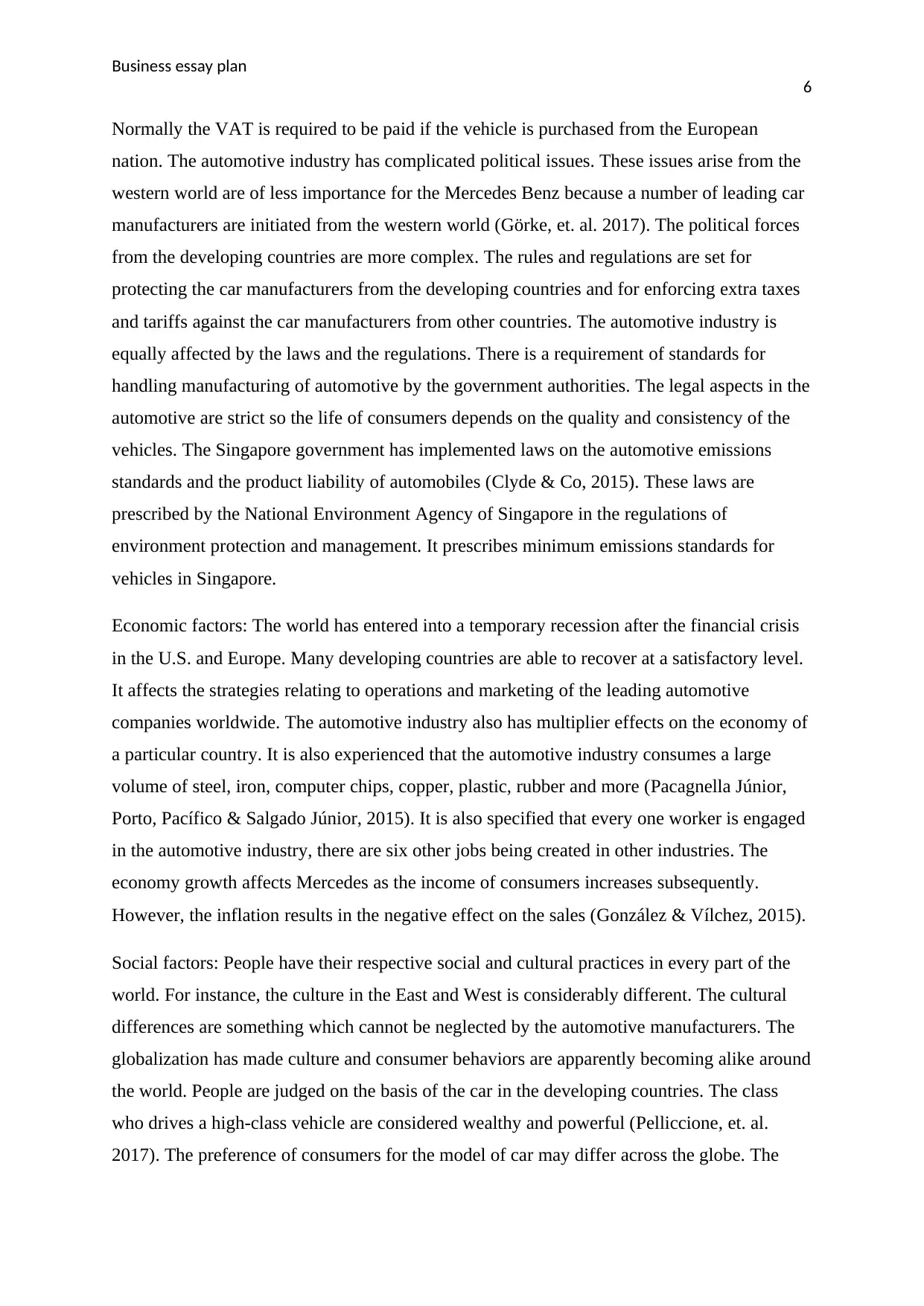
Business essay plan
6
Normally the VAT is required to be paid if the vehicle is purchased from the European
nation. The automotive industry has complicated political issues. These issues arise from the
western world are of less importance for the Mercedes Benz because a number of leading car
manufacturers are initiated from the western world (Görke, et. al. 2017). The political forces
from the developing countries are more complex. The rules and regulations are set for
protecting the car manufacturers from the developing countries and for enforcing extra taxes
and tariffs against the car manufacturers from other countries. The automotive industry is
equally affected by the laws and the regulations. There is a requirement of standards for
handling manufacturing of automotive by the government authorities. The legal aspects in the
automotive are strict so the life of consumers depends on the quality and consistency of the
vehicles. The Singapore government has implemented laws on the automotive emissions
standards and the product liability of automobiles (Clyde & Co, 2015). These laws are
prescribed by the National Environment Agency of Singapore in the regulations of
environment protection and management. It prescribes minimum emissions standards for
vehicles in Singapore.
Economic factors: The world has entered into a temporary recession after the financial crisis
in the U.S. and Europe. Many developing countries are able to recover at a satisfactory level.
It affects the strategies relating to operations and marketing of the leading automotive
companies worldwide. The automotive industry also has multiplier effects on the economy of
a particular country. It is also experienced that the automotive industry consumes a large
volume of steel, iron, computer chips, copper, plastic, rubber and more (Pacagnella Júnior,
Porto, Pacífico & Salgado Júnior, 2015). It is also specified that every one worker is engaged
in the automotive industry, there are six other jobs being created in other industries. The
economy growth affects Mercedes as the income of consumers increases subsequently.
However, the inflation results in the negative effect on the sales (González & Vílchez, 2015).
Social factors: People have their respective social and cultural practices in every part of the
world. For instance, the culture in the East and West is considerably different. The cultural
differences are something which cannot be neglected by the automotive manufacturers. The
globalization has made culture and consumer behaviors are apparently becoming alike around
the world. People are judged on the basis of the car in the developing countries. The class
who drives a high-class vehicle are considered wealthy and powerful (Pelliccione, et. al.
2017). The preference of consumers for the model of car may differ across the globe. The
6
Normally the VAT is required to be paid if the vehicle is purchased from the European
nation. The automotive industry has complicated political issues. These issues arise from the
western world are of less importance for the Mercedes Benz because a number of leading car
manufacturers are initiated from the western world (Görke, et. al. 2017). The political forces
from the developing countries are more complex. The rules and regulations are set for
protecting the car manufacturers from the developing countries and for enforcing extra taxes
and tariffs against the car manufacturers from other countries. The automotive industry is
equally affected by the laws and the regulations. There is a requirement of standards for
handling manufacturing of automotive by the government authorities. The legal aspects in the
automotive are strict so the life of consumers depends on the quality and consistency of the
vehicles. The Singapore government has implemented laws on the automotive emissions
standards and the product liability of automobiles (Clyde & Co, 2015). These laws are
prescribed by the National Environment Agency of Singapore in the regulations of
environment protection and management. It prescribes minimum emissions standards for
vehicles in Singapore.
Economic factors: The world has entered into a temporary recession after the financial crisis
in the U.S. and Europe. Many developing countries are able to recover at a satisfactory level.
It affects the strategies relating to operations and marketing of the leading automotive
companies worldwide. The automotive industry also has multiplier effects on the economy of
a particular country. It is also experienced that the automotive industry consumes a large
volume of steel, iron, computer chips, copper, plastic, rubber and more (Pacagnella Júnior,
Porto, Pacífico & Salgado Júnior, 2015). It is also specified that every one worker is engaged
in the automotive industry, there are six other jobs being created in other industries. The
economy growth affects Mercedes as the income of consumers increases subsequently.
However, the inflation results in the negative effect on the sales (González & Vílchez, 2015).
Social factors: People have their respective social and cultural practices in every part of the
world. For instance, the culture in the East and West is considerably different. The cultural
differences are something which cannot be neglected by the automotive manufacturers. The
globalization has made culture and consumer behaviors are apparently becoming alike around
the world. People are judged on the basis of the car in the developing countries. The class
who drives a high-class vehicle are considered wealthy and powerful (Pelliccione, et. al.
2017). The preference of consumers for the model of car may differ across the globe. The
Paraphrase This Document
Need a fresh take? Get an instant paraphrase of this document with our AI Paraphraser
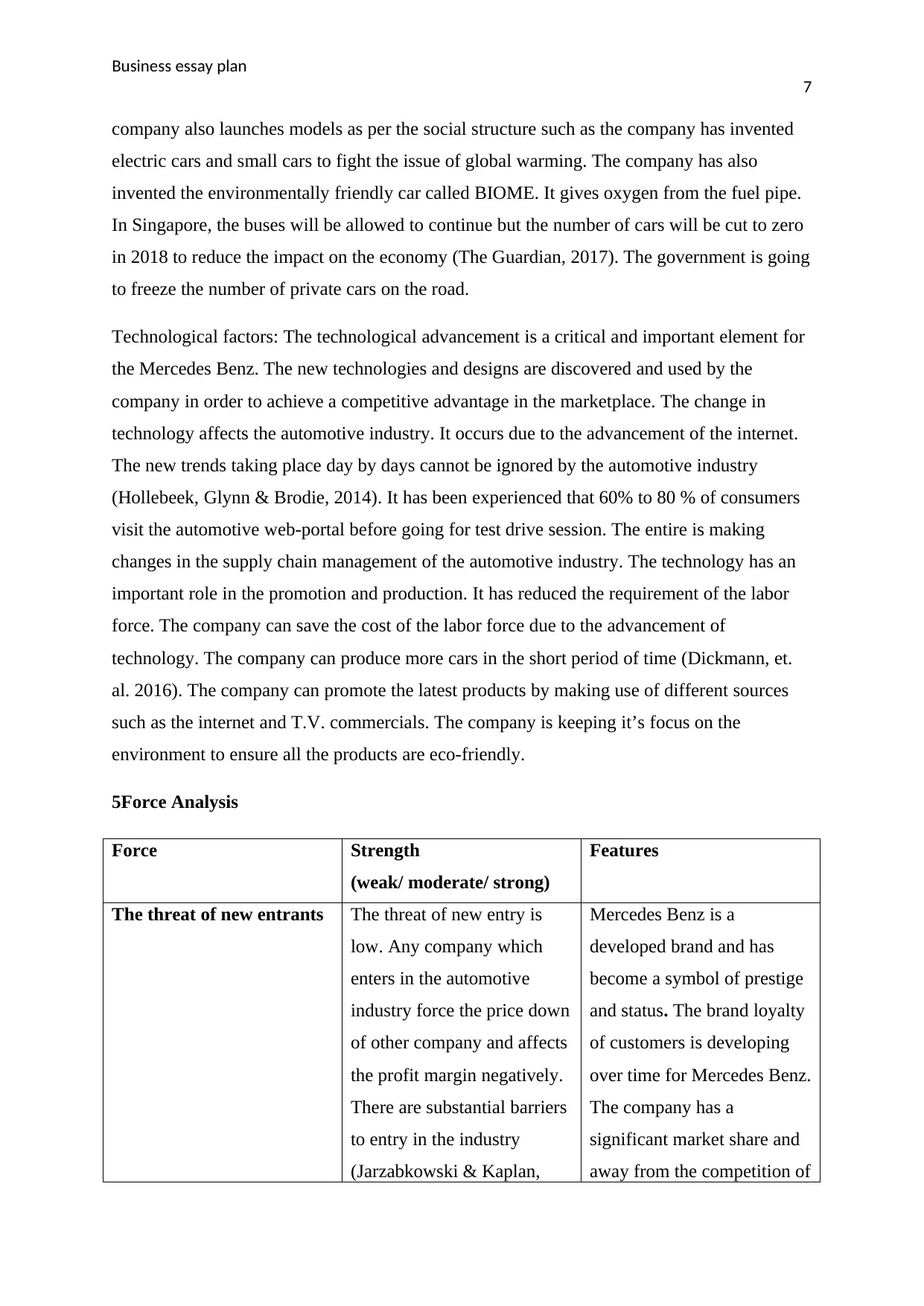
Business essay plan
7
company also launches models as per the social structure such as the company has invented
electric cars and small cars to fight the issue of global warming. The company has also
invented the environmentally friendly car called BIOME. It gives oxygen from the fuel pipe.
In Singapore, the buses will be allowed to continue but the number of cars will be cut to zero
in 2018 to reduce the impact on the economy (The Guardian, 2017). The government is going
to freeze the number of private cars on the road.
Technological factors: The technological advancement is a critical and important element for
the Mercedes Benz. The new technologies and designs are discovered and used by the
company in order to achieve a competitive advantage in the marketplace. The change in
technology affects the automotive industry. It occurs due to the advancement of the internet.
The new trends taking place day by days cannot be ignored by the automotive industry
(Hollebeek, Glynn & Brodie, 2014). It has been experienced that 60% to 80 % of consumers
visit the automotive web-portal before going for test drive session. The entire is making
changes in the supply chain management of the automotive industry. The technology has an
important role in the promotion and production. It has reduced the requirement of the labor
force. The company can save the cost of the labor force due to the advancement of
technology. The company can produce more cars in the short period of time (Dickmann, et.
al. 2016). The company can promote the latest products by making use of different sources
such as the internet and T.V. commercials. The company is keeping it’s focus on the
environment to ensure all the products are eco-friendly.
5Force Analysis
Force Strength
(weak/ moderate/ strong)
Features
The threat of new entrants The threat of new entry is
low. Any company which
enters in the automotive
industry force the price down
of other company and affects
the profit margin negatively.
There are substantial barriers
to entry in the industry
(Jarzabkowski & Kaplan,
Mercedes Benz is a
developed brand and has
become a symbol of prestige
and status. The brand loyalty
of customers is developing
over time for Mercedes Benz.
The company has a
significant market share and
away from the competition of
7
company also launches models as per the social structure such as the company has invented
electric cars and small cars to fight the issue of global warming. The company has also
invented the environmentally friendly car called BIOME. It gives oxygen from the fuel pipe.
In Singapore, the buses will be allowed to continue but the number of cars will be cut to zero
in 2018 to reduce the impact on the economy (The Guardian, 2017). The government is going
to freeze the number of private cars on the road.
Technological factors: The technological advancement is a critical and important element for
the Mercedes Benz. The new technologies and designs are discovered and used by the
company in order to achieve a competitive advantage in the marketplace. The change in
technology affects the automotive industry. It occurs due to the advancement of the internet.
The new trends taking place day by days cannot be ignored by the automotive industry
(Hollebeek, Glynn & Brodie, 2014). It has been experienced that 60% to 80 % of consumers
visit the automotive web-portal before going for test drive session. The entire is making
changes in the supply chain management of the automotive industry. The technology has an
important role in the promotion and production. It has reduced the requirement of the labor
force. The company can save the cost of the labor force due to the advancement of
technology. The company can produce more cars in the short period of time (Dickmann, et.
al. 2016). The company can promote the latest products by making use of different sources
such as the internet and T.V. commercials. The company is keeping it’s focus on the
environment to ensure all the products are eco-friendly.
5Force Analysis
Force Strength
(weak/ moderate/ strong)
Features
The threat of new entrants The threat of new entry is
low. Any company which
enters in the automotive
industry force the price down
of other company and affects
the profit margin negatively.
There are substantial barriers
to entry in the industry
(Jarzabkowski & Kaplan,
Mercedes Benz is a
developed brand and has
become a symbol of prestige
and status. The brand loyalty
of customers is developing
over time for Mercedes Benz.
The company has a
significant market share and
away from the competition of
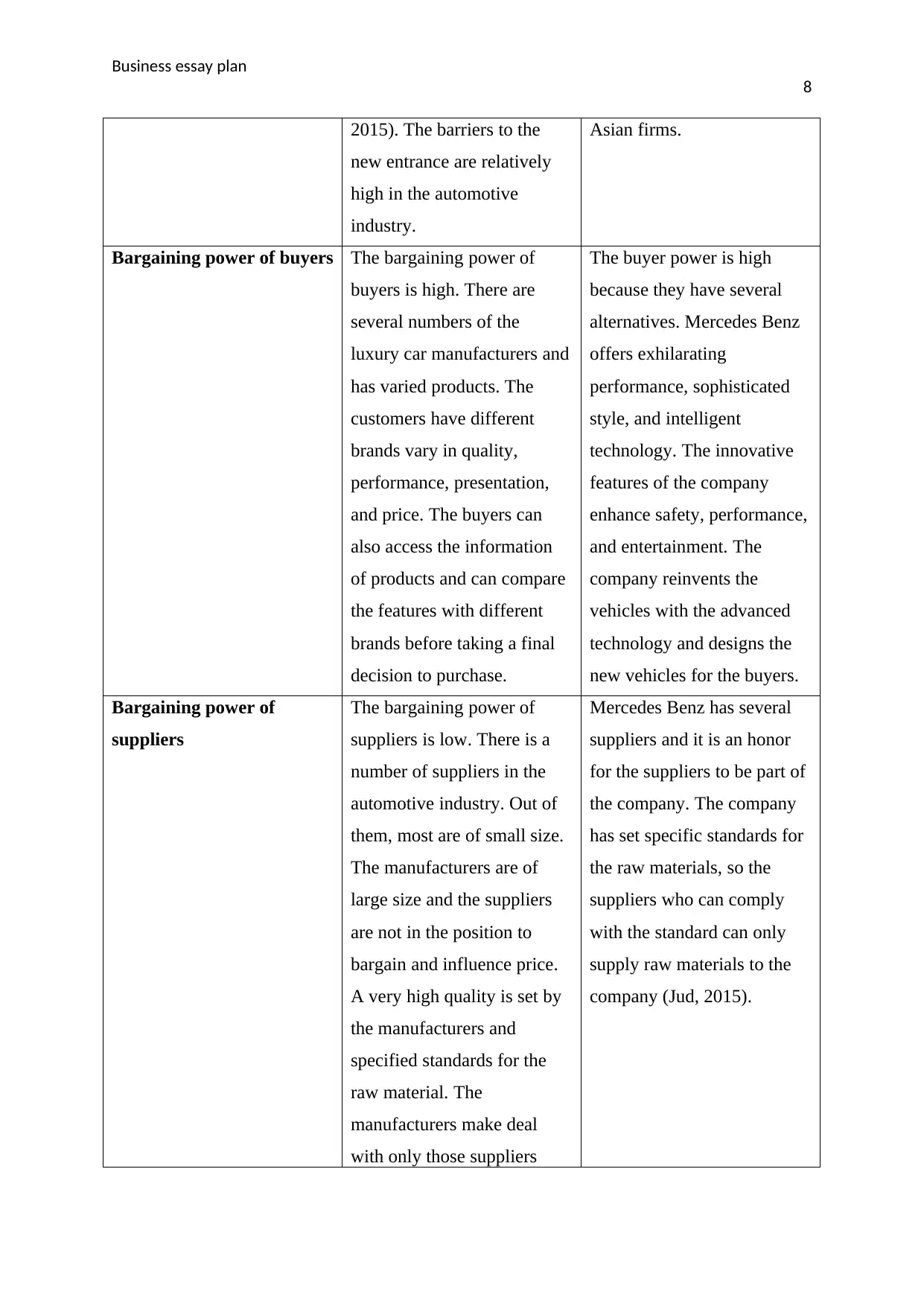
Business essay plan
8
2015). The barriers to the
new entrance are relatively
high in the automotive
industry.
Asian firms.
Bargaining power of buyers The bargaining power of
buyers is high. There are
several numbers of the
luxury car manufacturers and
has varied products. The
customers have different
brands vary in quality,
performance, presentation,
and price. The buyers can
also access the information
of products and can compare
the features with different
brands before taking a final
decision to purchase.
The buyer power is high
because they have several
alternatives. Mercedes Benz
offers exhilarating
performance, sophisticated
style, and intelligent
technology. The innovative
features of the company
enhance safety, performance,
and entertainment. The
company reinvents the
vehicles with the advanced
technology and designs the
new vehicles for the buyers.
Bargaining power of
suppliers
The bargaining power of
suppliers is low. There is a
number of suppliers in the
automotive industry. Out of
them, most are of small size.
The manufacturers are of
large size and the suppliers
are not in the position to
bargain and influence price.
A very high quality is set by
the manufacturers and
specified standards for the
raw material. The
manufacturers make deal
with only those suppliers
Mercedes Benz has several
suppliers and it is an honor
for the suppliers to be part of
the company. The company
has set specific standards for
the raw materials, so the
suppliers who can comply
with the standard can only
supply raw materials to the
company (Jud, 2015).
8
2015). The barriers to the
new entrance are relatively
high in the automotive
industry.
Asian firms.
Bargaining power of buyers The bargaining power of
buyers is high. There are
several numbers of the
luxury car manufacturers and
has varied products. The
customers have different
brands vary in quality,
performance, presentation,
and price. The buyers can
also access the information
of products and can compare
the features with different
brands before taking a final
decision to purchase.
The buyer power is high
because they have several
alternatives. Mercedes Benz
offers exhilarating
performance, sophisticated
style, and intelligent
technology. The innovative
features of the company
enhance safety, performance,
and entertainment. The
company reinvents the
vehicles with the advanced
technology and designs the
new vehicles for the buyers.
Bargaining power of
suppliers
The bargaining power of
suppliers is low. There is a
number of suppliers in the
automotive industry. Out of
them, most are of small size.
The manufacturers are of
large size and the suppliers
are not in the position to
bargain and influence price.
A very high quality is set by
the manufacturers and
specified standards for the
raw material. The
manufacturers make deal
with only those suppliers
Mercedes Benz has several
suppliers and it is an honor
for the suppliers to be part of
the company. The company
has set specific standards for
the raw materials, so the
suppliers who can comply
with the standard can only
supply raw materials to the
company (Jud, 2015).
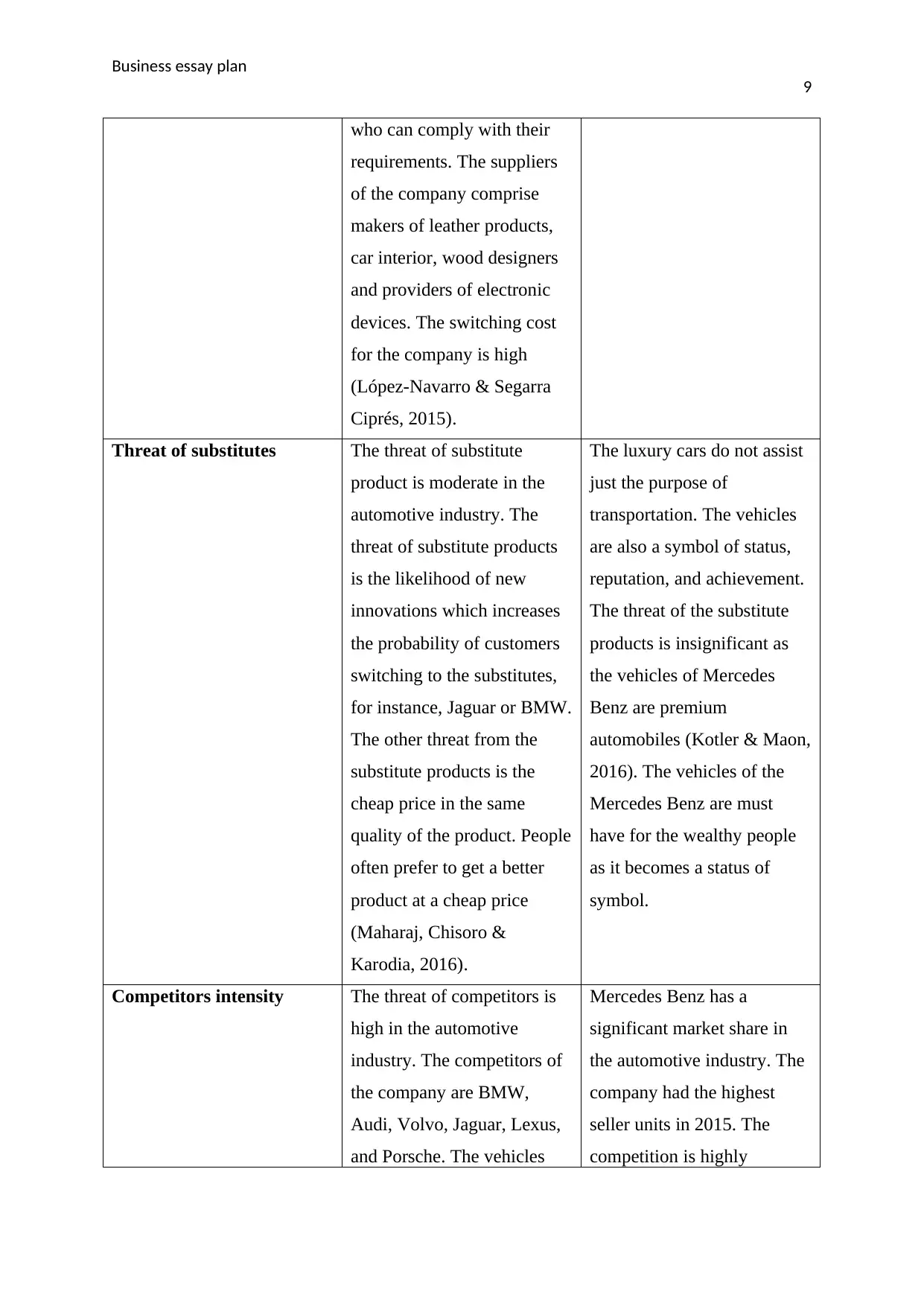
Business essay plan
9
who can comply with their
requirements. The suppliers
of the company comprise
makers of leather products,
car interior, wood designers
and providers of electronic
devices. The switching cost
for the company is high
(López-Navarro & Segarra
Ciprés, 2015).
Threat of substitutes The threat of substitute
product is moderate in the
automotive industry. The
threat of substitute products
is the likelihood of new
innovations which increases
the probability of customers
switching to the substitutes,
for instance, Jaguar or BMW.
The other threat from the
substitute products is the
cheap price in the same
quality of the product. People
often prefer to get a better
product at a cheap price
(Maharaj, Chisoro &
Karodia, 2016).
The luxury cars do not assist
just the purpose of
transportation. The vehicles
are also a symbol of status,
reputation, and achievement.
The threat of the substitute
products is insignificant as
the vehicles of Mercedes
Benz are premium
automobiles (Kotler & Maon,
2016). The vehicles of the
Mercedes Benz are must
have for the wealthy people
as it becomes a status of
symbol.
Competitors intensity The threat of competitors is
high in the automotive
industry. The competitors of
the company are BMW,
Audi, Volvo, Jaguar, Lexus,
and Porsche. The vehicles
Mercedes Benz has a
significant market share in
the automotive industry. The
company had the highest
seller units in 2015. The
competition is highly
9
who can comply with their
requirements. The suppliers
of the company comprise
makers of leather products,
car interior, wood designers
and providers of electronic
devices. The switching cost
for the company is high
(López-Navarro & Segarra
Ciprés, 2015).
Threat of substitutes The threat of substitute
product is moderate in the
automotive industry. The
threat of substitute products
is the likelihood of new
innovations which increases
the probability of customers
switching to the substitutes,
for instance, Jaguar or BMW.
The other threat from the
substitute products is the
cheap price in the same
quality of the product. People
often prefer to get a better
product at a cheap price
(Maharaj, Chisoro &
Karodia, 2016).
The luxury cars do not assist
just the purpose of
transportation. The vehicles
are also a symbol of status,
reputation, and achievement.
The threat of the substitute
products is insignificant as
the vehicles of Mercedes
Benz are premium
automobiles (Kotler & Maon,
2016). The vehicles of the
Mercedes Benz are must
have for the wealthy people
as it becomes a status of
symbol.
Competitors intensity The threat of competitors is
high in the automotive
industry. The competitors of
the company are BMW,
Audi, Volvo, Jaguar, Lexus,
and Porsche. The vehicles
Mercedes Benz has a
significant market share in
the automotive industry. The
company had the highest
seller units in 2015. The
competition is highly
Secure Best Marks with AI Grader
Need help grading? Try our AI Grader for instant feedback on your assignments.
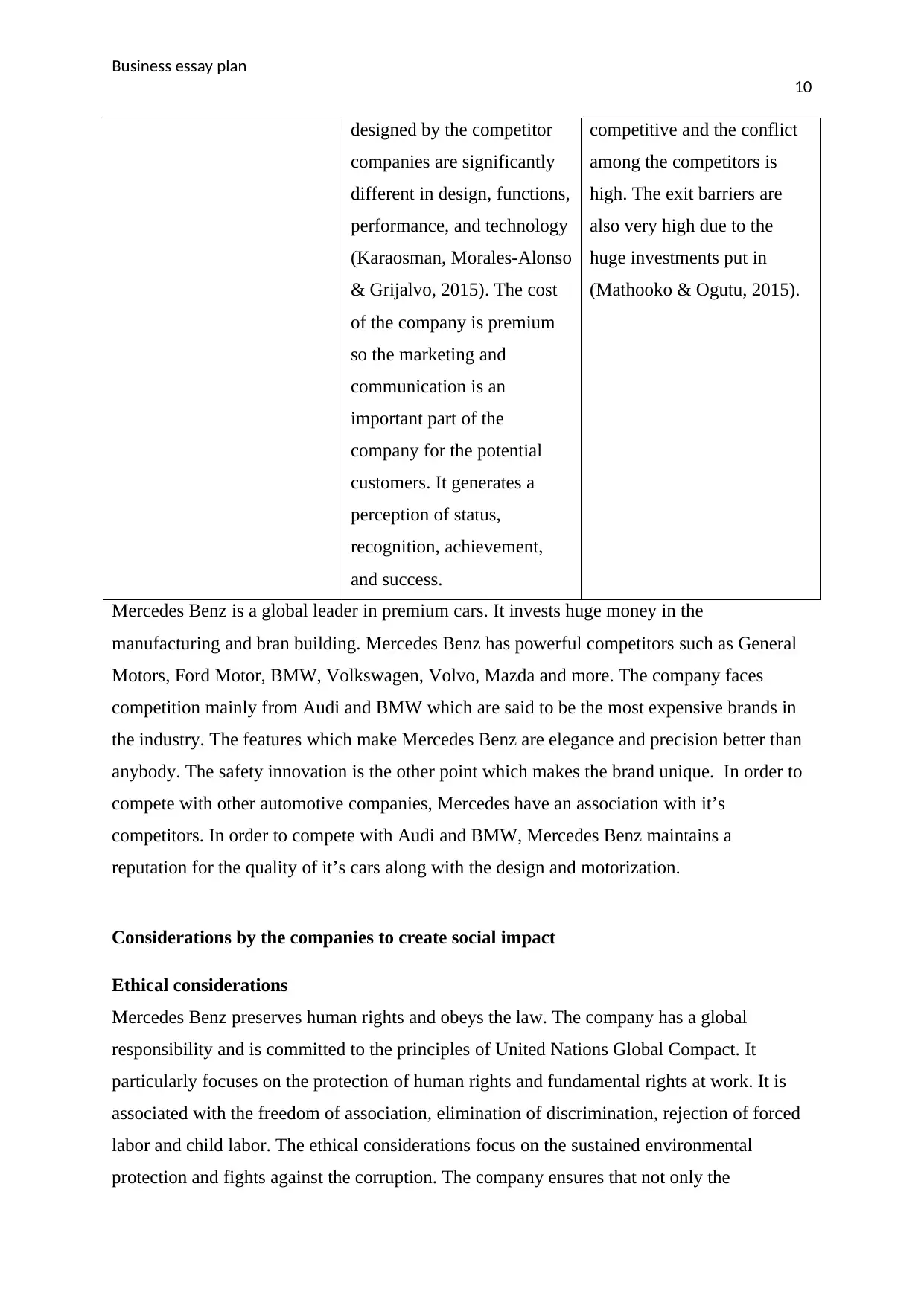
Business essay plan
10
designed by the competitor
companies are significantly
different in design, functions,
performance, and technology
(Karaosman, Morales-Alonso
& Grijalvo, 2015). The cost
of the company is premium
so the marketing and
communication is an
important part of the
company for the potential
customers. It generates a
perception of status,
recognition, achievement,
and success.
competitive and the conflict
among the competitors is
high. The exit barriers are
also very high due to the
huge investments put in
(Mathooko & Ogutu, 2015).
Mercedes Benz is a global leader in premium cars. It invests huge money in the
manufacturing and bran building. Mercedes Benz has powerful competitors such as General
Motors, Ford Motor, BMW, Volkswagen, Volvo, Mazda and more. The company faces
competition mainly from Audi and BMW which are said to be the most expensive brands in
the industry. The features which make Mercedes Benz are elegance and precision better than
anybody. The safety innovation is the other point which makes the brand unique. In order to
compete with other automotive companies, Mercedes have an association with it’s
competitors. In order to compete with Audi and BMW, Mercedes Benz maintains a
reputation for the quality of it’s cars along with the design and motorization.
Considerations by the companies to create social impact
Ethical considerations
Mercedes Benz preserves human rights and obeys the law. The company has a global
responsibility and is committed to the principles of United Nations Global Compact. It
particularly focuses on the protection of human rights and fundamental rights at work. It is
associated with the freedom of association, elimination of discrimination, rejection of forced
labor and child labor. The ethical considerations focus on the sustained environmental
protection and fights against the corruption. The company ensures that not only the
10
designed by the competitor
companies are significantly
different in design, functions,
performance, and technology
(Karaosman, Morales-Alonso
& Grijalvo, 2015). The cost
of the company is premium
so the marketing and
communication is an
important part of the
company for the potential
customers. It generates a
perception of status,
recognition, achievement,
and success.
competitive and the conflict
among the competitors is
high. The exit barriers are
also very high due to the
huge investments put in
(Mathooko & Ogutu, 2015).
Mercedes Benz is a global leader in premium cars. It invests huge money in the
manufacturing and bran building. Mercedes Benz has powerful competitors such as General
Motors, Ford Motor, BMW, Volkswagen, Volvo, Mazda and more. The company faces
competition mainly from Audi and BMW which are said to be the most expensive brands in
the industry. The features which make Mercedes Benz are elegance and precision better than
anybody. The safety innovation is the other point which makes the brand unique. In order to
compete with other automotive companies, Mercedes have an association with it’s
competitors. In order to compete with Audi and BMW, Mercedes Benz maintains a
reputation for the quality of it’s cars along with the design and motorization.
Considerations by the companies to create social impact
Ethical considerations
Mercedes Benz preserves human rights and obeys the law. The company has a global
responsibility and is committed to the principles of United Nations Global Compact. It
particularly focuses on the protection of human rights and fundamental rights at work. It is
associated with the freedom of association, elimination of discrimination, rejection of forced
labor and child labor. The ethical considerations focus on the sustained environmental
protection and fights against the corruption. The company ensures that not only the
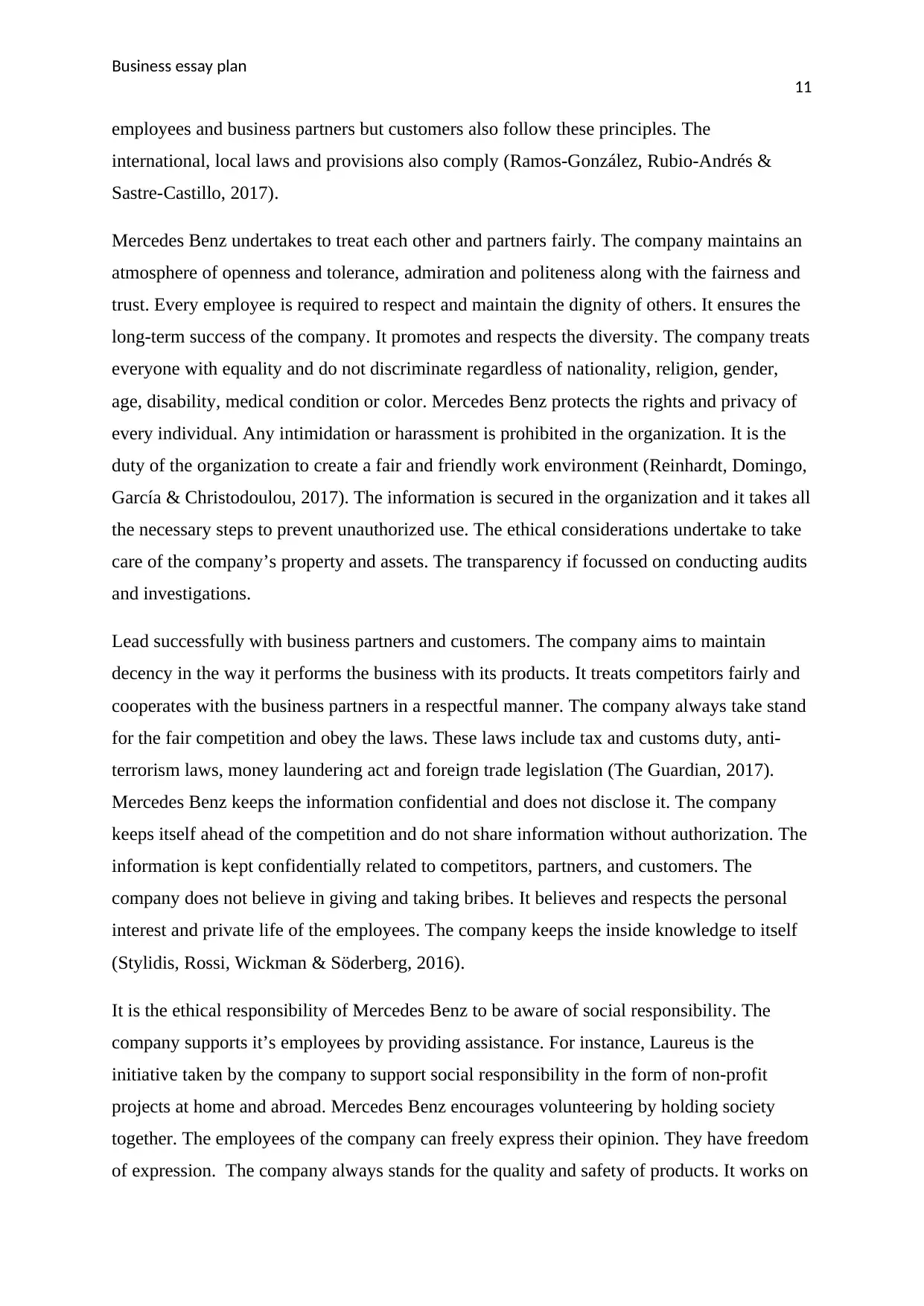
Business essay plan
11
employees and business partners but customers also follow these principles. The
international, local laws and provisions also comply (Ramos-González, Rubio-Andrés &
Sastre-Castillo, 2017).
Mercedes Benz undertakes to treat each other and partners fairly. The company maintains an
atmosphere of openness and tolerance, admiration and politeness along with the fairness and
trust. Every employee is required to respect and maintain the dignity of others. It ensures the
long-term success of the company. It promotes and respects the diversity. The company treats
everyone with equality and do not discriminate regardless of nationality, religion, gender,
age, disability, medical condition or color. Mercedes Benz protects the rights and privacy of
every individual. Any intimidation or harassment is prohibited in the organization. It is the
duty of the organization to create a fair and friendly work environment (Reinhardt, Domingo,
García & Christodoulou, 2017). The information is secured in the organization and it takes all
the necessary steps to prevent unauthorized use. The ethical considerations undertake to take
care of the company’s property and assets. The transparency if focussed on conducting audits
and investigations.
Lead successfully with business partners and customers. The company aims to maintain
decency in the way it performs the business with its products. It treats competitors fairly and
cooperates with the business partners in a respectful manner. The company always take stand
for the fair competition and obey the laws. These laws include tax and customs duty, anti-
terrorism laws, money laundering act and foreign trade legislation (The Guardian, 2017).
Mercedes Benz keeps the information confidential and does not disclose it. The company
keeps itself ahead of the competition and do not share information without authorization. The
information is kept confidentially related to competitors, partners, and customers. The
company does not believe in giving and taking bribes. It believes and respects the personal
interest and private life of the employees. The company keeps the inside knowledge to itself
(Stylidis, Rossi, Wickman & Söderberg, 2016).
It is the ethical responsibility of Mercedes Benz to be aware of social responsibility. The
company supports it’s employees by providing assistance. For instance, Laureus is the
initiative taken by the company to support social responsibility in the form of non-profit
projects at home and abroad. Mercedes Benz encourages volunteering by holding society
together. The employees of the company can freely express their opinion. They have freedom
of expression. The company always stands for the quality and safety of products. It works on
11
employees and business partners but customers also follow these principles. The
international, local laws and provisions also comply (Ramos-González, Rubio-Andrés &
Sastre-Castillo, 2017).
Mercedes Benz undertakes to treat each other and partners fairly. The company maintains an
atmosphere of openness and tolerance, admiration and politeness along with the fairness and
trust. Every employee is required to respect and maintain the dignity of others. It ensures the
long-term success of the company. It promotes and respects the diversity. The company treats
everyone with equality and do not discriminate regardless of nationality, religion, gender,
age, disability, medical condition or color. Mercedes Benz protects the rights and privacy of
every individual. Any intimidation or harassment is prohibited in the organization. It is the
duty of the organization to create a fair and friendly work environment (Reinhardt, Domingo,
García & Christodoulou, 2017). The information is secured in the organization and it takes all
the necessary steps to prevent unauthorized use. The ethical considerations undertake to take
care of the company’s property and assets. The transparency if focussed on conducting audits
and investigations.
Lead successfully with business partners and customers. The company aims to maintain
decency in the way it performs the business with its products. It treats competitors fairly and
cooperates with the business partners in a respectful manner. The company always take stand
for the fair competition and obey the laws. These laws include tax and customs duty, anti-
terrorism laws, money laundering act and foreign trade legislation (The Guardian, 2017).
Mercedes Benz keeps the information confidential and does not disclose it. The company
keeps itself ahead of the competition and do not share information without authorization. The
information is kept confidentially related to competitors, partners, and customers. The
company does not believe in giving and taking bribes. It believes and respects the personal
interest and private life of the employees. The company keeps the inside knowledge to itself
(Stylidis, Rossi, Wickman & Söderberg, 2016).
It is the ethical responsibility of Mercedes Benz to be aware of social responsibility. The
company supports it’s employees by providing assistance. For instance, Laureus is the
initiative taken by the company to support social responsibility in the form of non-profit
projects at home and abroad. Mercedes Benz encourages volunteering by holding society
together. The employees of the company can freely express their opinion. They have freedom
of expression. The company always stands for the quality and safety of products. It works on
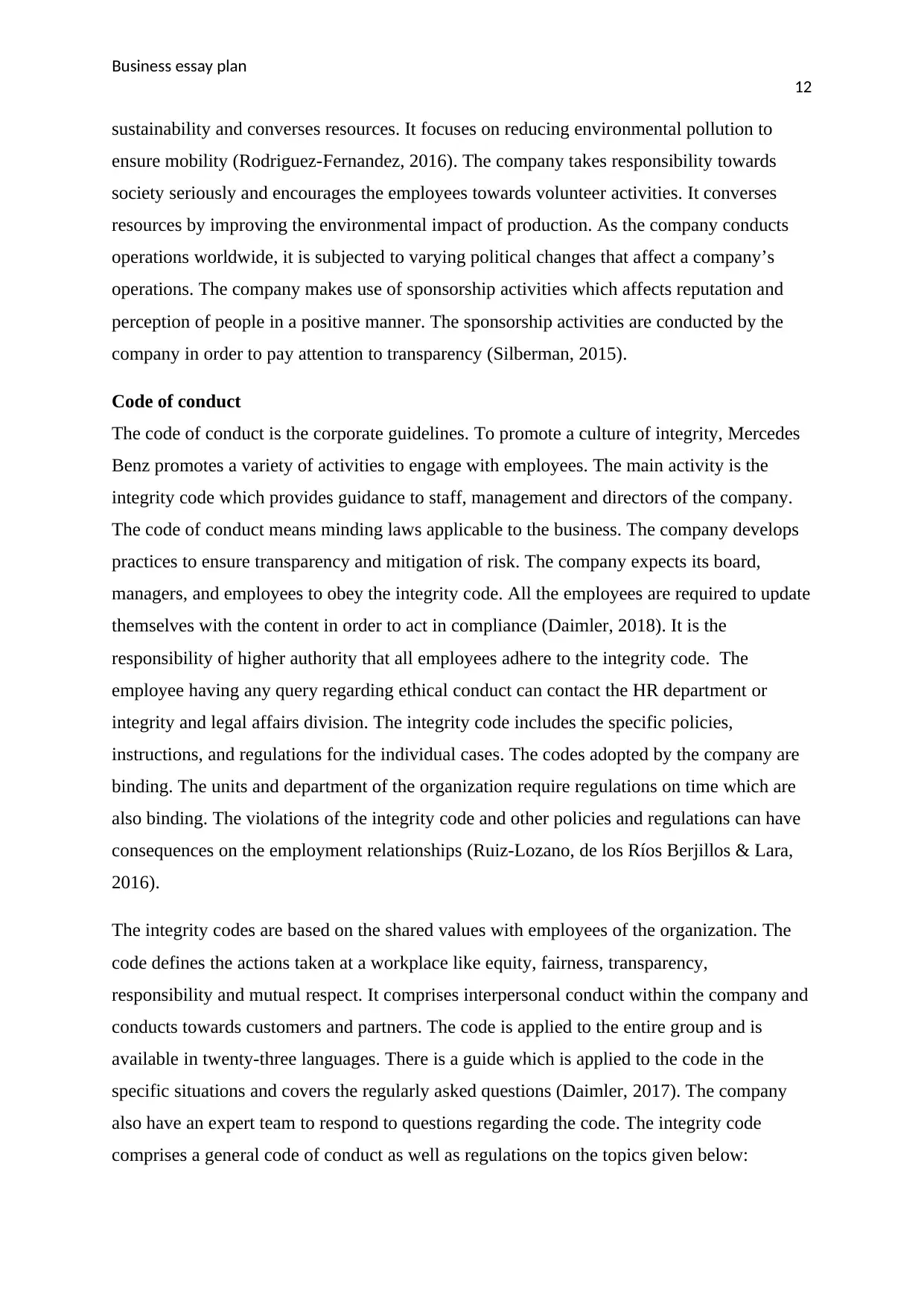
Business essay plan
12
sustainability and converses resources. It focuses on reducing environmental pollution to
ensure mobility (Rodriguez-Fernandez, 2016). The company takes responsibility towards
society seriously and encourages the employees towards volunteer activities. It converses
resources by improving the environmental impact of production. As the company conducts
operations worldwide, it is subjected to varying political changes that affect a company’s
operations. The company makes use of sponsorship activities which affects reputation and
perception of people in a positive manner. The sponsorship activities are conducted by the
company in order to pay attention to transparency (Silberman, 2015).
Code of conduct
The code of conduct is the corporate guidelines. To promote a culture of integrity, Mercedes
Benz promotes a variety of activities to engage with employees. The main activity is the
integrity code which provides guidance to staff, management and directors of the company.
The code of conduct means minding laws applicable to the business. The company develops
practices to ensure transparency and mitigation of risk. The company expects its board,
managers, and employees to obey the integrity code. All the employees are required to update
themselves with the content in order to act in compliance (Daimler, 2018). It is the
responsibility of higher authority that all employees adhere to the integrity code. The
employee having any query regarding ethical conduct can contact the HR department or
integrity and legal affairs division. The integrity code includes the specific policies,
instructions, and regulations for the individual cases. The codes adopted by the company are
binding. The units and department of the organization require regulations on time which are
also binding. The violations of the integrity code and other policies and regulations can have
consequences on the employment relationships (Ruiz-Lozano, de los Ríos Berjillos & Lara,
2016).
The integrity codes are based on the shared values with employees of the organization. The
code defines the actions taken at a workplace like equity, fairness, transparency,
responsibility and mutual respect. It comprises interpersonal conduct within the company and
conducts towards customers and partners. The code is applied to the entire group and is
available in twenty-three languages. There is a guide which is applied to the code in the
specific situations and covers the regularly asked questions (Daimler, 2017). The company
also have an expert team to respond to questions regarding the code. The integrity code
comprises a general code of conduct as well as regulations on the topics given below:
12
sustainability and converses resources. It focuses on reducing environmental pollution to
ensure mobility (Rodriguez-Fernandez, 2016). The company takes responsibility towards
society seriously and encourages the employees towards volunteer activities. It converses
resources by improving the environmental impact of production. As the company conducts
operations worldwide, it is subjected to varying political changes that affect a company’s
operations. The company makes use of sponsorship activities which affects reputation and
perception of people in a positive manner. The sponsorship activities are conducted by the
company in order to pay attention to transparency (Silberman, 2015).
Code of conduct
The code of conduct is the corporate guidelines. To promote a culture of integrity, Mercedes
Benz promotes a variety of activities to engage with employees. The main activity is the
integrity code which provides guidance to staff, management and directors of the company.
The code of conduct means minding laws applicable to the business. The company develops
practices to ensure transparency and mitigation of risk. The company expects its board,
managers, and employees to obey the integrity code. All the employees are required to update
themselves with the content in order to act in compliance (Daimler, 2018). It is the
responsibility of higher authority that all employees adhere to the integrity code. The
employee having any query regarding ethical conduct can contact the HR department or
integrity and legal affairs division. The integrity code includes the specific policies,
instructions, and regulations for the individual cases. The codes adopted by the company are
binding. The units and department of the organization require regulations on time which are
also binding. The violations of the integrity code and other policies and regulations can have
consequences on the employment relationships (Ruiz-Lozano, de los Ríos Berjillos & Lara,
2016).
The integrity codes are based on the shared values with employees of the organization. The
code defines the actions taken at a workplace like equity, fairness, transparency,
responsibility and mutual respect. It comprises interpersonal conduct within the company and
conducts towards customers and partners. The code is applied to the entire group and is
available in twenty-three languages. There is a guide which is applied to the code in the
specific situations and covers the regularly asked questions (Daimler, 2017). The company
also have an expert team to respond to questions regarding the code. The integrity code
comprises a general code of conduct as well as regulations on the topics given below:
Paraphrase This Document
Need a fresh take? Get an instant paraphrase of this document with our AI Paraphraser
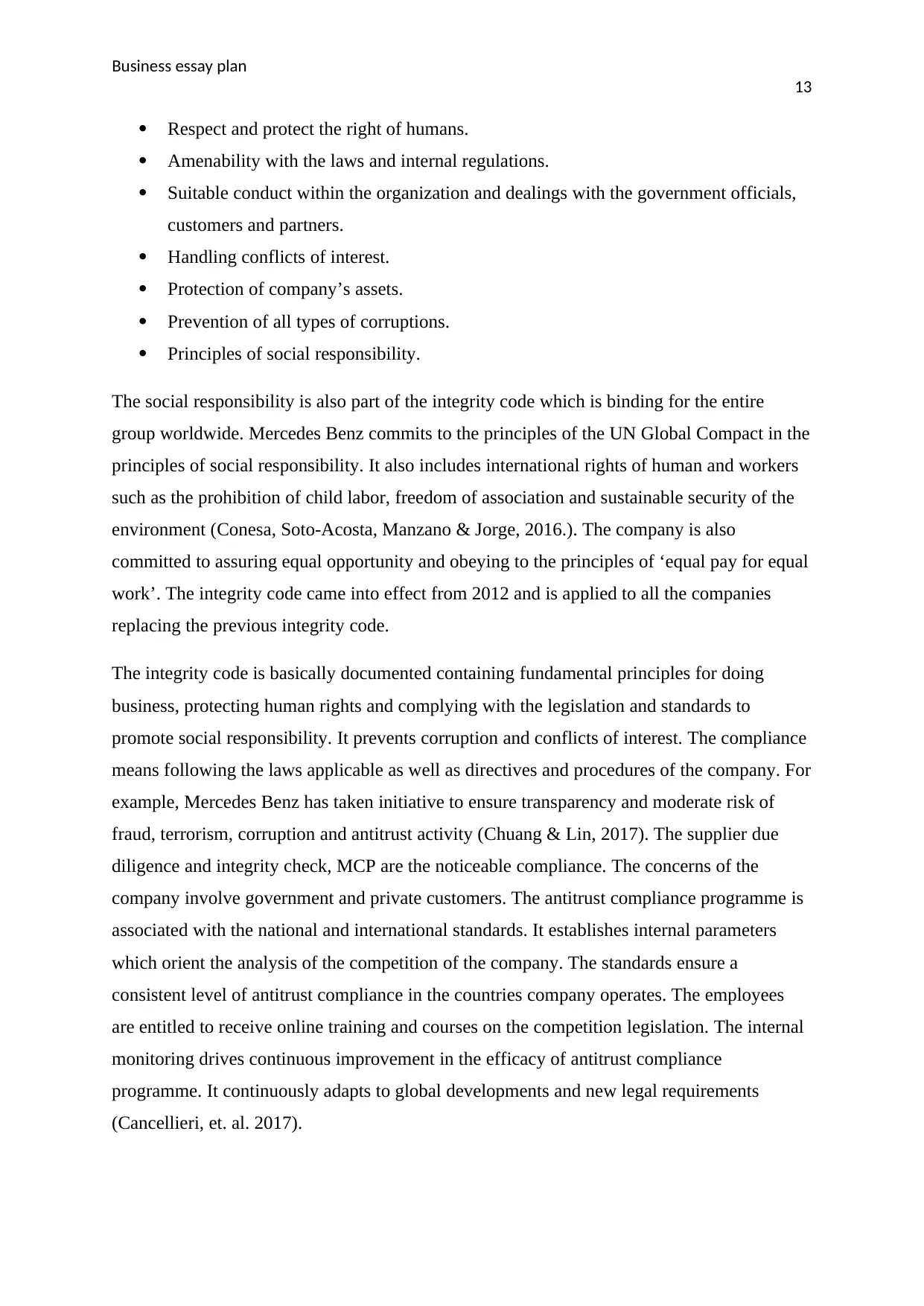
Business essay plan
13
Respect and protect the right of humans.
Amenability with the laws and internal regulations.
Suitable conduct within the organization and dealings with the government officials,
customers and partners.
Handling conflicts of interest.
Protection of company’s assets.
Prevention of all types of corruptions.
Principles of social responsibility.
The social responsibility is also part of the integrity code which is binding for the entire
group worldwide. Mercedes Benz commits to the principles of the UN Global Compact in the
principles of social responsibility. It also includes international rights of human and workers
such as the prohibition of child labor, freedom of association and sustainable security of the
environment (Conesa, Soto-Acosta, Manzano & Jorge, 2016.). The company is also
committed to assuring equal opportunity and obeying to the principles of ‘equal pay for equal
work’. The integrity code came into effect from 2012 and is applied to all the companies
replacing the previous integrity code.
The integrity code is basically documented containing fundamental principles for doing
business, protecting human rights and complying with the legislation and standards to
promote social responsibility. It prevents corruption and conflicts of interest. The compliance
means following the laws applicable as well as directives and procedures of the company. For
example, Mercedes Benz has taken initiative to ensure transparency and moderate risk of
fraud, terrorism, corruption and antitrust activity (Chuang & Lin, 2017). The supplier due
diligence and integrity check, MCP are the noticeable compliance. The concerns of the
company involve government and private customers. The antitrust compliance programme is
associated with the national and international standards. It establishes internal parameters
which orient the analysis of the competition of the company. The standards ensure a
consistent level of antitrust compliance in the countries company operates. The employees
are entitled to receive online training and courses on the competition legislation. The internal
monitoring drives continuous improvement in the efficacy of antitrust compliance
programme. It continuously adapts to global developments and new legal requirements
(Cancellieri, et. al. 2017).
13
Respect and protect the right of humans.
Amenability with the laws and internal regulations.
Suitable conduct within the organization and dealings with the government officials,
customers and partners.
Handling conflicts of interest.
Protection of company’s assets.
Prevention of all types of corruptions.
Principles of social responsibility.
The social responsibility is also part of the integrity code which is binding for the entire
group worldwide. Mercedes Benz commits to the principles of the UN Global Compact in the
principles of social responsibility. It also includes international rights of human and workers
such as the prohibition of child labor, freedom of association and sustainable security of the
environment (Conesa, Soto-Acosta, Manzano & Jorge, 2016.). The company is also
committed to assuring equal opportunity and obeying to the principles of ‘equal pay for equal
work’. The integrity code came into effect from 2012 and is applied to all the companies
replacing the previous integrity code.
The integrity code is basically documented containing fundamental principles for doing
business, protecting human rights and complying with the legislation and standards to
promote social responsibility. It prevents corruption and conflicts of interest. The compliance
means following the laws applicable as well as directives and procedures of the company. For
example, Mercedes Benz has taken initiative to ensure transparency and moderate risk of
fraud, terrorism, corruption and antitrust activity (Chuang & Lin, 2017). The supplier due
diligence and integrity check, MCP are the noticeable compliance. The concerns of the
company involve government and private customers. The antitrust compliance programme is
associated with the national and international standards. It establishes internal parameters
which orient the analysis of the competition of the company. The standards ensure a
consistent level of antitrust compliance in the countries company operates. The employees
are entitled to receive online training and courses on the competition legislation. The internal
monitoring drives continuous improvement in the efficacy of antitrust compliance
programme. It continuously adapts to global developments and new legal requirements
(Cancellieri, et. al. 2017).

Business essay plan
14
Needs of stakeholders
The stakeholders have an interest in the outcome and are normally within the company.
Mercedes Benz engages with the stakeholders to identify the urgent needs and expectations
of the company. The company is required to approach customers and coordinate with them.
The community engagement is a good example to identify and meet the need of stakeholders.
Employees: Mercedes Benz makes use of Work advance model to work effectively
with employers. Such model incorporates a postemployment advancement component
which is new to the providers. The providers deliver components along with the post-
employment services. The company offers the base salary which is determined by the
function and level of employee. The final compensation of the employees is
determined by the tasks, performances, qualification, and experience. The company
provides a special benefit to the employees like pension plans and health insurance
coverage. It also makes a significant contribution to the future of employees with a
financed pension scheme and other attractive provisions (Bakker, Maat & Van Wee,
2014).
Customers: Mercedes Benz aims to create value for the customers. It wins customers
with it’s outstanding quality. The company understands the need of customers by
creating an interface for sales and aftersales processes. It ensures to maintain contact
with customers all the time. The company also provides added value to the customers.
The tailored transport and mobility services are also provided to the customers. It
improves efficiency and reflects the growing trend towards a sharing economy.
Suppliers: The company offers a special learning program to the suppliers. The
suppliers are provided training on the topics like processes, quality assurance and the
requirements of the company. The Mercedes Benz supplier academy is a great
opportunity for the new and start-up suppliers who are having no experience in the
automotive industry. The maximum fifteen participants are trained about the
procedure and standards of the company’s supplier management (Böke, Maier,
Moisel, & Herold, 2015). The employees are responsible for the purchasing and the
quality of suppliers.
Society: Mercedes Benz supports the projects which promote the common good. The
company cooperates to people as they contribute to the sustainable development and
can have a long-term impact. It provides support to the society in the form of
donations, sponsorships, funding through foundations and more (Baudy, Koehl,
14
Needs of stakeholders
The stakeholders have an interest in the outcome and are normally within the company.
Mercedes Benz engages with the stakeholders to identify the urgent needs and expectations
of the company. The company is required to approach customers and coordinate with them.
The community engagement is a good example to identify and meet the need of stakeholders.
Employees: Mercedes Benz makes use of Work advance model to work effectively
with employers. Such model incorporates a postemployment advancement component
which is new to the providers. The providers deliver components along with the post-
employment services. The company offers the base salary which is determined by the
function and level of employee. The final compensation of the employees is
determined by the tasks, performances, qualification, and experience. The company
provides a special benefit to the employees like pension plans and health insurance
coverage. It also makes a significant contribution to the future of employees with a
financed pension scheme and other attractive provisions (Bakker, Maat & Van Wee,
2014).
Customers: Mercedes Benz aims to create value for the customers. It wins customers
with it’s outstanding quality. The company understands the need of customers by
creating an interface for sales and aftersales processes. It ensures to maintain contact
with customers all the time. The company also provides added value to the customers.
The tailored transport and mobility services are also provided to the customers. It
improves efficiency and reflects the growing trend towards a sharing economy.
Suppliers: The company offers a special learning program to the suppliers. The
suppliers are provided training on the topics like processes, quality assurance and the
requirements of the company. The Mercedes Benz supplier academy is a great
opportunity for the new and start-up suppliers who are having no experience in the
automotive industry. The maximum fifteen participants are trained about the
procedure and standards of the company’s supplier management (Böke, Maier,
Moisel, & Herold, 2015). The employees are responsible for the purchasing and the
quality of suppliers.
Society: Mercedes Benz supports the projects which promote the common good. The
company cooperates to people as they contribute to the sustainable development and
can have a long-term impact. It provides support to the society in the form of
donations, sponsorships, funding through foundations and more (Baudy, Koehl,

Business essay plan
15
Menges,& Reichert, 2015). The company also initiates to provide education to the
society which helps to attain long-term investment in the company. It also supports
the young people who can be skilled employees of tomorrow.
Interest groups: The UN Global Compact protects human rights. It gives importance
to rights of employees, fair working conditions, environmental protection, fight
against corruption and more. The human rights are one of the top priorities. It has also
specified operational responsibilities, integrity code and key requirements of the
employees and business partners (Russo-Spena, Tregua & De Chiara, 2016).
CSR actions: Mercedes Benz tries to focus on the local issues where communities are
profited and sustained. The company engages local people in the successful
implementation of it’s projects. The motive of the company is to improve the quality
of education, provide basic facilities and healthier lifestyle to the marginalized people.
It also aims to provide facilities to the local community with clean drinking water
systems. The company seeks to implement facilities which focus on creating an
impact on the society and the public which reduces the gap between all stakeholders
(Barkmeyer, Kaluza, Pastewski, Thiede & Herrmann, 2016).
Mercedes Benz has great concern for the environmental protection. The company
offers 58 models which significantly reduce burning on the environment. The
innovations under such a strategy are known as Blue efficiency.
The company is also working on reducing environmental risks by working closely
with the suppliers who are environmentally responsible and fulfills the sustainability
requirements. It also has a team of auditors which analyses the environmental risks
strictly (Böttcher & Müller, 2015).
Academic theories
The PEST analysis is helpful to the Mercedes Benz in expanding operations worldwide. The
VAT is requisite to be paid on the vehicles purchased from the European nation. The
company faces more complicated political issues in the developing countries. The recession
and financial crisis affect the operations and marketing strategies of the Mercedes Benz. The
economic growth also affects the company as the income of people increases, the demand
also increases subsequently. Though, the inflation has a negative impact on the sales of the
company. There is a different culture in every part of the world. The globalization has made
culture and consumer behaviors similar around the globe. The culture is given more
15
Menges,& Reichert, 2015). The company also initiates to provide education to the
society which helps to attain long-term investment in the company. It also supports
the young people who can be skilled employees of tomorrow.
Interest groups: The UN Global Compact protects human rights. It gives importance
to rights of employees, fair working conditions, environmental protection, fight
against corruption and more. The human rights are one of the top priorities. It has also
specified operational responsibilities, integrity code and key requirements of the
employees and business partners (Russo-Spena, Tregua & De Chiara, 2016).
CSR actions: Mercedes Benz tries to focus on the local issues where communities are
profited and sustained. The company engages local people in the successful
implementation of it’s projects. The motive of the company is to improve the quality
of education, provide basic facilities and healthier lifestyle to the marginalized people.
It also aims to provide facilities to the local community with clean drinking water
systems. The company seeks to implement facilities which focus on creating an
impact on the society and the public which reduces the gap between all stakeholders
(Barkmeyer, Kaluza, Pastewski, Thiede & Herrmann, 2016).
Mercedes Benz has great concern for the environmental protection. The company
offers 58 models which significantly reduce burning on the environment. The
innovations under such a strategy are known as Blue efficiency.
The company is also working on reducing environmental risks by working closely
with the suppliers who are environmentally responsible and fulfills the sustainability
requirements. It also has a team of auditors which analyses the environmental risks
strictly (Böttcher & Müller, 2015).
Academic theories
The PEST analysis is helpful to the Mercedes Benz in expanding operations worldwide. The
VAT is requisite to be paid on the vehicles purchased from the European nation. The
company faces more complicated political issues in the developing countries. The recession
and financial crisis affect the operations and marketing strategies of the Mercedes Benz. The
economic growth also affects the company as the income of people increases, the demand
also increases subsequently. Though, the inflation has a negative impact on the sales of the
company. There is a different culture in every part of the world. The globalization has made
culture and consumer behaviors similar around the globe. The culture is given more
Secure Best Marks with AI Grader
Need help grading? Try our AI Grader for instant feedback on your assignments.
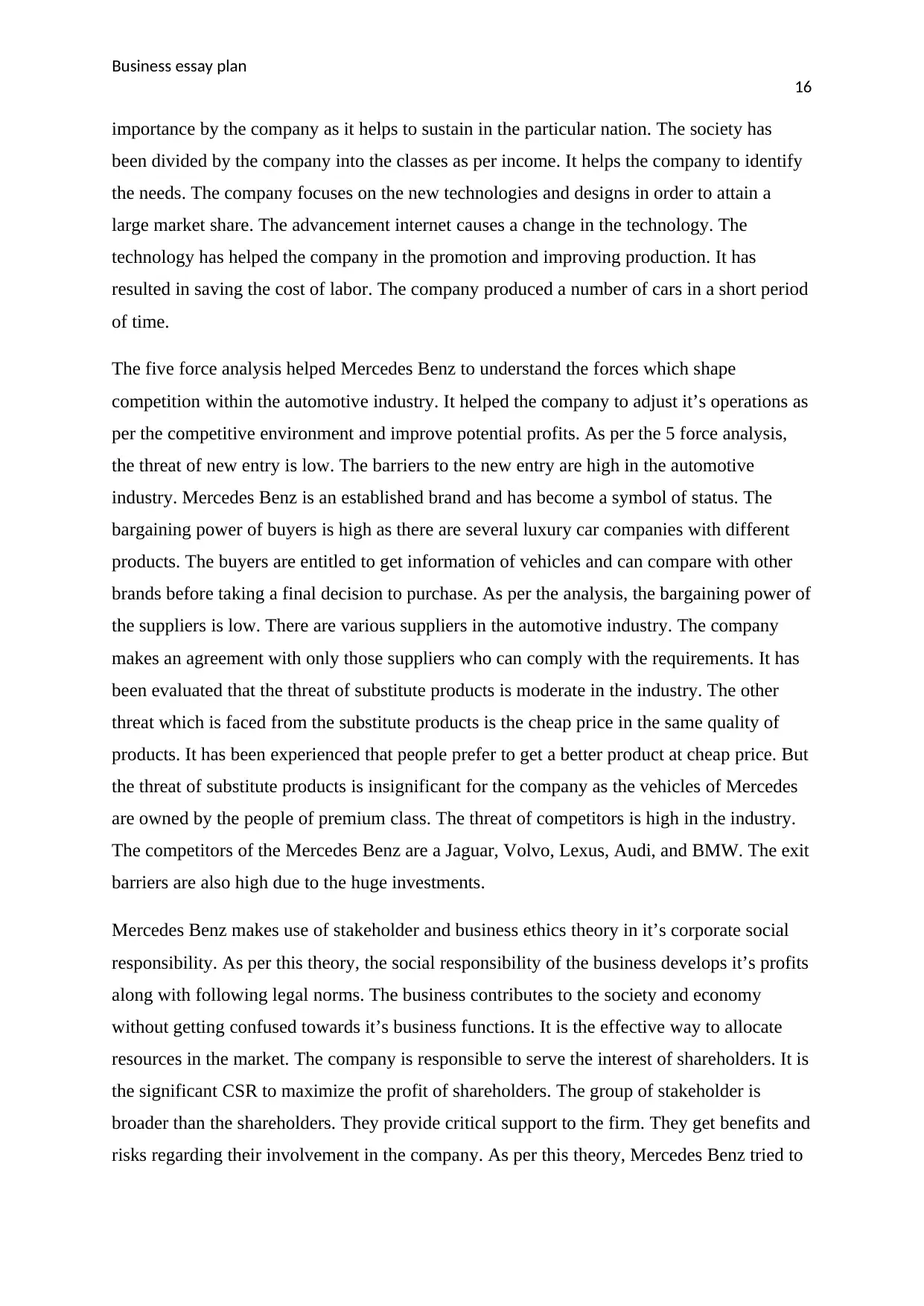
Business essay plan
16
importance by the company as it helps to sustain in the particular nation. The society has
been divided by the company into the classes as per income. It helps the company to identify
the needs. The company focuses on the new technologies and designs in order to attain a
large market share. The advancement internet causes a change in the technology. The
technology has helped the company in the promotion and improving production. It has
resulted in saving the cost of labor. The company produced a number of cars in a short period
of time.
The five force analysis helped Mercedes Benz to understand the forces which shape
competition within the automotive industry. It helped the company to adjust it’s operations as
per the competitive environment and improve potential profits. As per the 5 force analysis,
the threat of new entry is low. The barriers to the new entry are high in the automotive
industry. Mercedes Benz is an established brand and has become a symbol of status. The
bargaining power of buyers is high as there are several luxury car companies with different
products. The buyers are entitled to get information of vehicles and can compare with other
brands before taking a final decision to purchase. As per the analysis, the bargaining power of
the suppliers is low. There are various suppliers in the automotive industry. The company
makes an agreement with only those suppliers who can comply with the requirements. It has
been evaluated that the threat of substitute products is moderate in the industry. The other
threat which is faced from the substitute products is the cheap price in the same quality of
products. It has been experienced that people prefer to get a better product at cheap price. But
the threat of substitute products is insignificant for the company as the vehicles of Mercedes
are owned by the people of premium class. The threat of competitors is high in the industry.
The competitors of the Mercedes Benz are a Jaguar, Volvo, Lexus, Audi, and BMW. The exit
barriers are also high due to the huge investments.
Mercedes Benz makes use of stakeholder and business ethics theory in it’s corporate social
responsibility. As per this theory, the social responsibility of the business develops it’s profits
along with following legal norms. The business contributes to the society and economy
without getting confused towards it’s business functions. It is the effective way to allocate
resources in the market. The company is responsible to serve the interest of shareholders. It is
the significant CSR to maximize the profit of shareholders. The group of stakeholder is
broader than the shareholders. They provide critical support to the firm. They get benefits and
risks regarding their involvement in the company. As per this theory, Mercedes Benz tried to
16
importance by the company as it helps to sustain in the particular nation. The society has
been divided by the company into the classes as per income. It helps the company to identify
the needs. The company focuses on the new technologies and designs in order to attain a
large market share. The advancement internet causes a change in the technology. The
technology has helped the company in the promotion and improving production. It has
resulted in saving the cost of labor. The company produced a number of cars in a short period
of time.
The five force analysis helped Mercedes Benz to understand the forces which shape
competition within the automotive industry. It helped the company to adjust it’s operations as
per the competitive environment and improve potential profits. As per the 5 force analysis,
the threat of new entry is low. The barriers to the new entry are high in the automotive
industry. Mercedes Benz is an established brand and has become a symbol of status. The
bargaining power of buyers is high as there are several luxury car companies with different
products. The buyers are entitled to get information of vehicles and can compare with other
brands before taking a final decision to purchase. As per the analysis, the bargaining power of
the suppliers is low. There are various suppliers in the automotive industry. The company
makes an agreement with only those suppliers who can comply with the requirements. It has
been evaluated that the threat of substitute products is moderate in the industry. The other
threat which is faced from the substitute products is the cheap price in the same quality of
products. It has been experienced that people prefer to get a better product at cheap price. But
the threat of substitute products is insignificant for the company as the vehicles of Mercedes
are owned by the people of premium class. The threat of competitors is high in the industry.
The competitors of the Mercedes Benz are a Jaguar, Volvo, Lexus, Audi, and BMW. The exit
barriers are also high due to the huge investments.
Mercedes Benz makes use of stakeholder and business ethics theory in it’s corporate social
responsibility. As per this theory, the social responsibility of the business develops it’s profits
along with following legal norms. The business contributes to the society and economy
without getting confused towards it’s business functions. It is the effective way to allocate
resources in the market. The company is responsible to serve the interest of shareholders. It is
the significant CSR to maximize the profit of shareholders. The group of stakeholder is
broader than the shareholders. They provide critical support to the firm. They get benefits and
risks regarding their involvement in the company. As per this theory, Mercedes Benz tried to
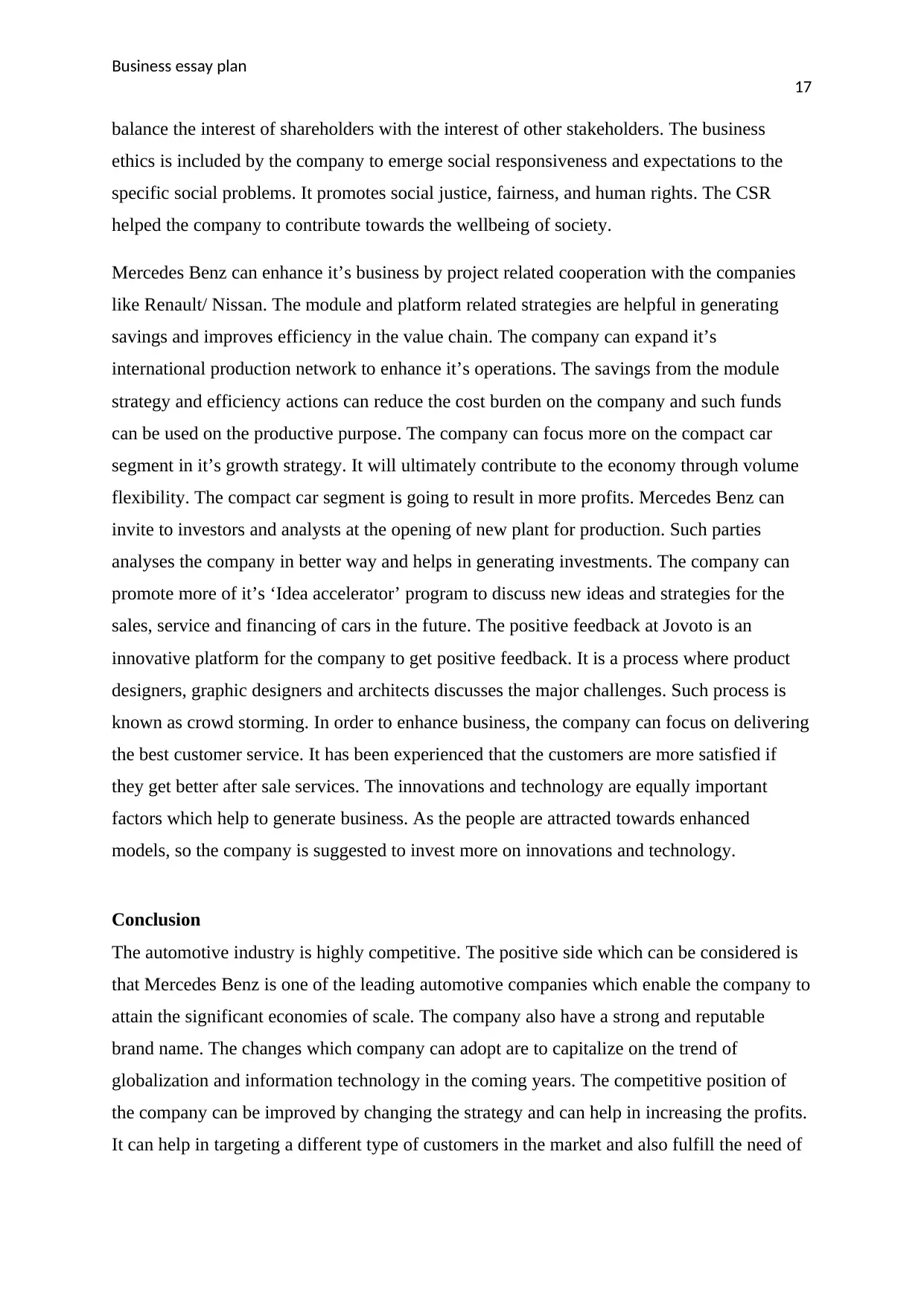
Business essay plan
17
balance the interest of shareholders with the interest of other stakeholders. The business
ethics is included by the company to emerge social responsiveness and expectations to the
specific social problems. It promotes social justice, fairness, and human rights. The CSR
helped the company to contribute towards the wellbeing of society.
Mercedes Benz can enhance it’s business by project related cooperation with the companies
like Renault/ Nissan. The module and platform related strategies are helpful in generating
savings and improves efficiency in the value chain. The company can expand it’s
international production network to enhance it’s operations. The savings from the module
strategy and efficiency actions can reduce the cost burden on the company and such funds
can be used on the productive purpose. The company can focus more on the compact car
segment in it’s growth strategy. It will ultimately contribute to the economy through volume
flexibility. The compact car segment is going to result in more profits. Mercedes Benz can
invite to investors and analysts at the opening of new plant for production. Such parties
analyses the company in better way and helps in generating investments. The company can
promote more of it’s ‘Idea accelerator’ program to discuss new ideas and strategies for the
sales, service and financing of cars in the future. The positive feedback at Jovoto is an
innovative platform for the company to get positive feedback. It is a process where product
designers, graphic designers and architects discusses the major challenges. Such process is
known as crowd storming. In order to enhance business, the company can focus on delivering
the best customer service. It has been experienced that the customers are more satisfied if
they get better after sale services. The innovations and technology are equally important
factors which help to generate business. As the people are attracted towards enhanced
models, so the company is suggested to invest more on innovations and technology.
Conclusion
The automotive industry is highly competitive. The positive side which can be considered is
that Mercedes Benz is one of the leading automotive companies which enable the company to
attain the significant economies of scale. The company also have a strong and reputable
brand name. The changes which company can adopt are to capitalize on the trend of
globalization and information technology in the coming years. The competitive position of
the company can be improved by changing the strategy and can help in increasing the profits.
It can help in targeting a different type of customers in the market and also fulfill the need of
17
balance the interest of shareholders with the interest of other stakeholders. The business
ethics is included by the company to emerge social responsiveness and expectations to the
specific social problems. It promotes social justice, fairness, and human rights. The CSR
helped the company to contribute towards the wellbeing of society.
Mercedes Benz can enhance it’s business by project related cooperation with the companies
like Renault/ Nissan. The module and platform related strategies are helpful in generating
savings and improves efficiency in the value chain. The company can expand it’s
international production network to enhance it’s operations. The savings from the module
strategy and efficiency actions can reduce the cost burden on the company and such funds
can be used on the productive purpose. The company can focus more on the compact car
segment in it’s growth strategy. It will ultimately contribute to the economy through volume
flexibility. The compact car segment is going to result in more profits. Mercedes Benz can
invite to investors and analysts at the opening of new plant for production. Such parties
analyses the company in better way and helps in generating investments. The company can
promote more of it’s ‘Idea accelerator’ program to discuss new ideas and strategies for the
sales, service and financing of cars in the future. The positive feedback at Jovoto is an
innovative platform for the company to get positive feedback. It is a process where product
designers, graphic designers and architects discusses the major challenges. Such process is
known as crowd storming. In order to enhance business, the company can focus on delivering
the best customer service. It has been experienced that the customers are more satisfied if
they get better after sale services. The innovations and technology are equally important
factors which help to generate business. As the people are attracted towards enhanced
models, so the company is suggested to invest more on innovations and technology.
Conclusion
The automotive industry is highly competitive. The positive side which can be considered is
that Mercedes Benz is one of the leading automotive companies which enable the company to
attain the significant economies of scale. The company also have a strong and reputable
brand name. The changes which company can adopt are to capitalize on the trend of
globalization and information technology in the coming years. The competitive position of
the company can be improved by changing the strategy and can help in increasing the profits.
It can help in targeting a different type of customers in the market and also fulfill the need of
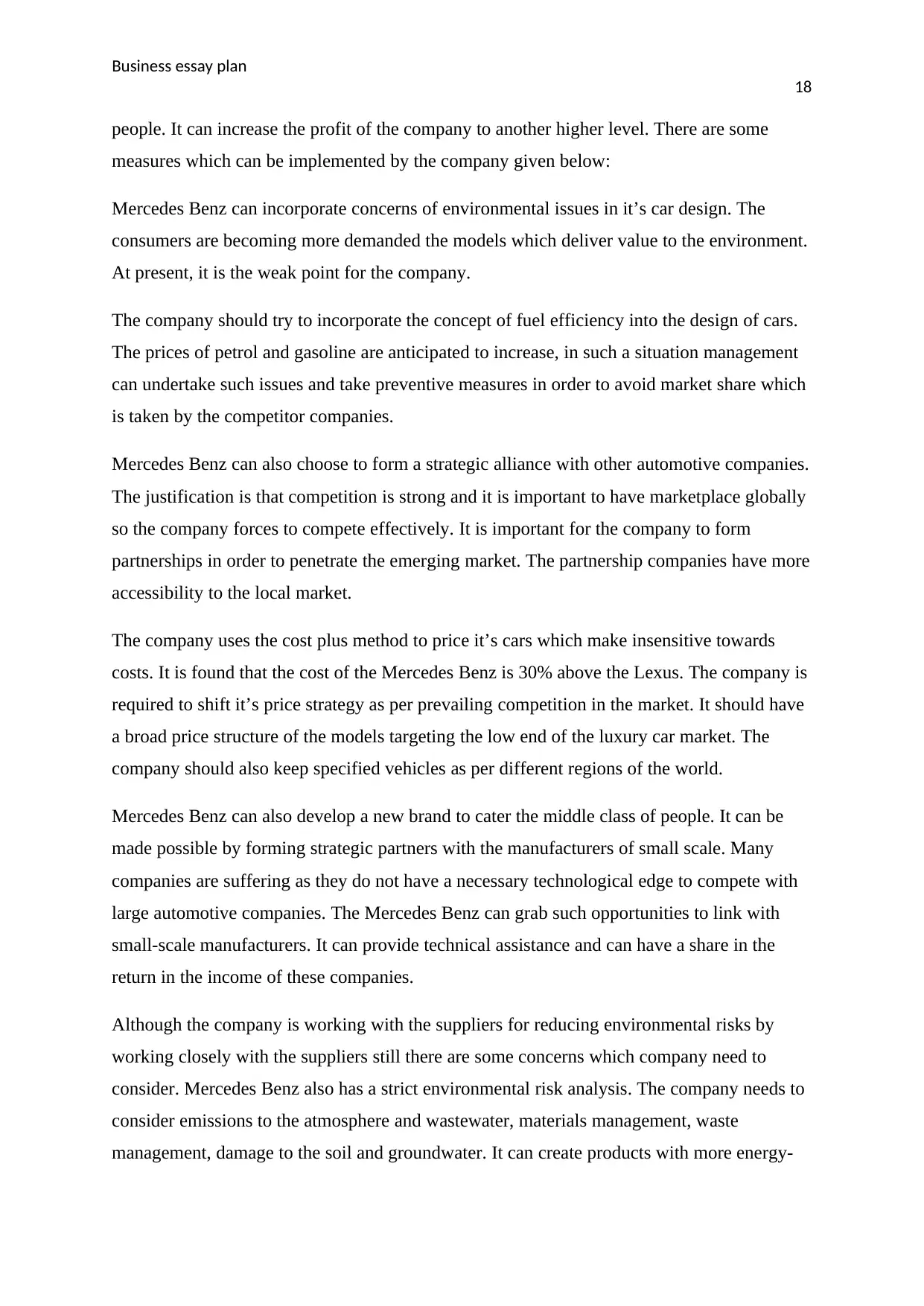
Business essay plan
18
people. It can increase the profit of the company to another higher level. There are some
measures which can be implemented by the company given below:
Mercedes Benz can incorporate concerns of environmental issues in it’s car design. The
consumers are becoming more demanded the models which deliver value to the environment.
At present, it is the weak point for the company.
The company should try to incorporate the concept of fuel efficiency into the design of cars.
The prices of petrol and gasoline are anticipated to increase, in such a situation management
can undertake such issues and take preventive measures in order to avoid market share which
is taken by the competitor companies.
Mercedes Benz can also choose to form a strategic alliance with other automotive companies.
The justification is that competition is strong and it is important to have marketplace globally
so the company forces to compete effectively. It is important for the company to form
partnerships in order to penetrate the emerging market. The partnership companies have more
accessibility to the local market.
The company uses the cost plus method to price it’s cars which make insensitive towards
costs. It is found that the cost of the Mercedes Benz is 30% above the Lexus. The company is
required to shift it’s price strategy as per prevailing competition in the market. It should have
a broad price structure of the models targeting the low end of the luxury car market. The
company should also keep specified vehicles as per different regions of the world.
Mercedes Benz can also develop a new brand to cater the middle class of people. It can be
made possible by forming strategic partners with the manufacturers of small scale. Many
companies are suffering as they do not have a necessary technological edge to compete with
large automotive companies. The Mercedes Benz can grab such opportunities to link with
small-scale manufacturers. It can provide technical assistance and can have a share in the
return in the income of these companies.
Although the company is working with the suppliers for reducing environmental risks by
working closely with the suppliers still there are some concerns which company need to
consider. Mercedes Benz also has a strict environmental risk analysis. The company needs to
consider emissions to the atmosphere and wastewater, materials management, waste
management, damage to the soil and groundwater. It can create products with more energy-
18
people. It can increase the profit of the company to another higher level. There are some
measures which can be implemented by the company given below:
Mercedes Benz can incorporate concerns of environmental issues in it’s car design. The
consumers are becoming more demanded the models which deliver value to the environment.
At present, it is the weak point for the company.
The company should try to incorporate the concept of fuel efficiency into the design of cars.
The prices of petrol and gasoline are anticipated to increase, in such a situation management
can undertake such issues and take preventive measures in order to avoid market share which
is taken by the competitor companies.
Mercedes Benz can also choose to form a strategic alliance with other automotive companies.
The justification is that competition is strong and it is important to have marketplace globally
so the company forces to compete effectively. It is important for the company to form
partnerships in order to penetrate the emerging market. The partnership companies have more
accessibility to the local market.
The company uses the cost plus method to price it’s cars which make insensitive towards
costs. It is found that the cost of the Mercedes Benz is 30% above the Lexus. The company is
required to shift it’s price strategy as per prevailing competition in the market. It should have
a broad price structure of the models targeting the low end of the luxury car market. The
company should also keep specified vehicles as per different regions of the world.
Mercedes Benz can also develop a new brand to cater the middle class of people. It can be
made possible by forming strategic partners with the manufacturers of small scale. Many
companies are suffering as they do not have a necessary technological edge to compete with
large automotive companies. The Mercedes Benz can grab such opportunities to link with
small-scale manufacturers. It can provide technical assistance and can have a share in the
return in the income of these companies.
Although the company is working with the suppliers for reducing environmental risks by
working closely with the suppliers still there are some concerns which company need to
consider. Mercedes Benz also has a strict environmental risk analysis. The company needs to
consider emissions to the atmosphere and wastewater, materials management, waste
management, damage to the soil and groundwater. It can create products with more energy-
Paraphrase This Document
Need a fresh take? Get an instant paraphrase of this document with our AI Paraphraser
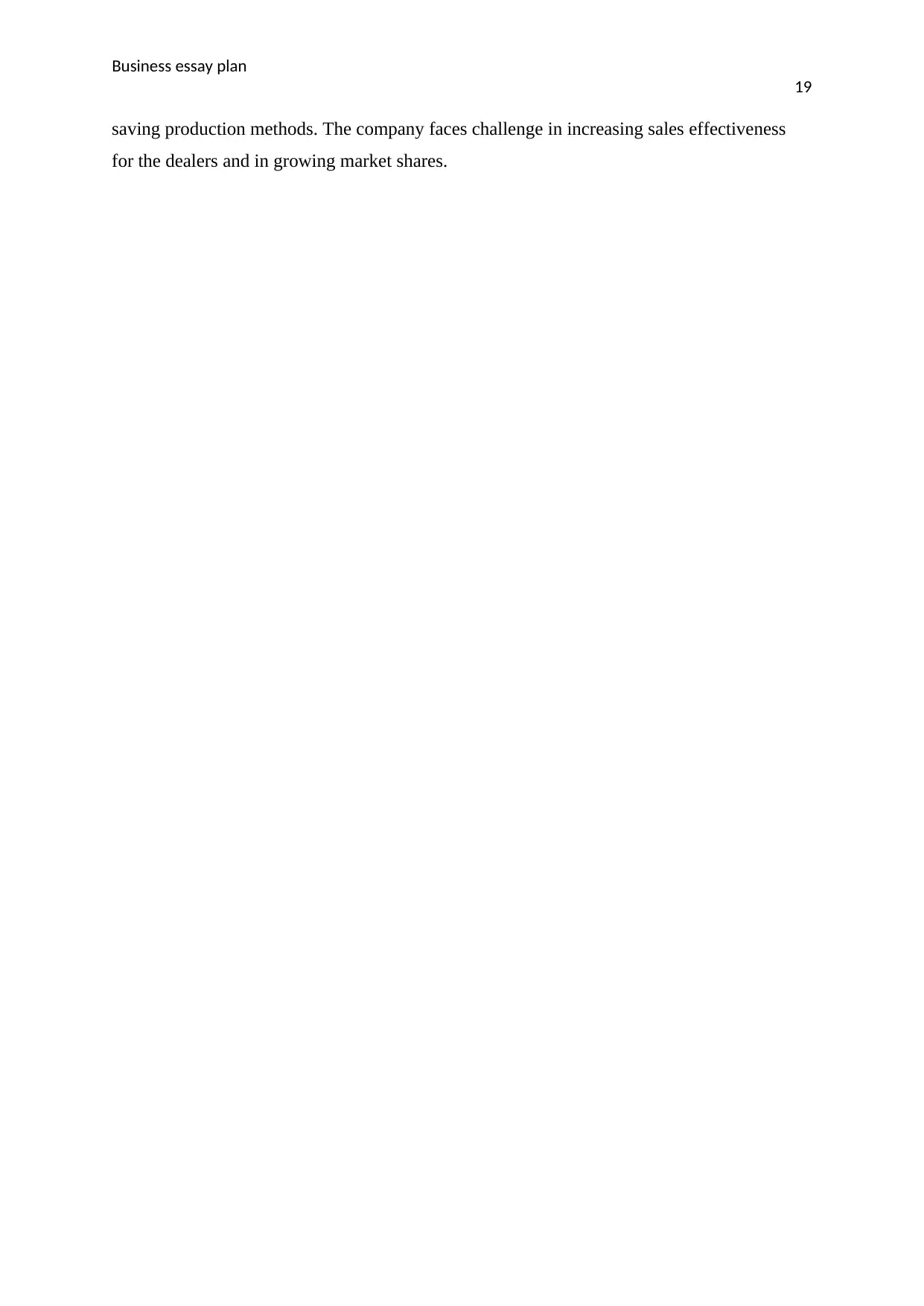
Business essay plan
19
saving production methods. The company faces challenge in increasing sales effectiveness
for the dealers and in growing market shares.
19
saving production methods. The company faces challenge in increasing sales effectiveness
for the dealers and in growing market shares.
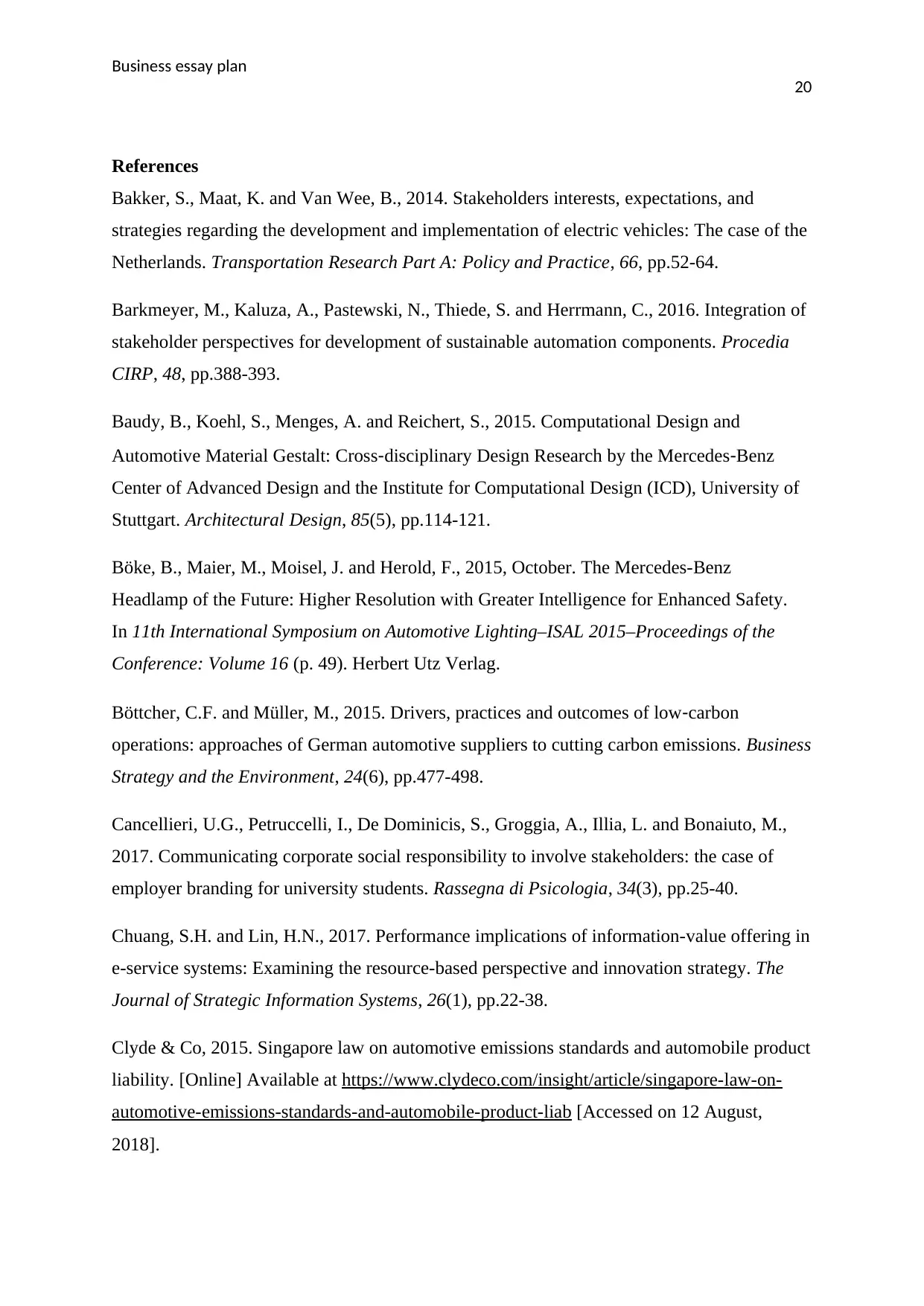
Business essay plan
20
References
Bakker, S., Maat, K. and Van Wee, B., 2014. Stakeholders interests, expectations, and
strategies regarding the development and implementation of electric vehicles: The case of the
Netherlands. Transportation Research Part A: Policy and Practice, 66, pp.52-64.
Barkmeyer, M., Kaluza, A., Pastewski, N., Thiede, S. and Herrmann, C., 2016. Integration of
stakeholder perspectives for development of sustainable automation components. Procedia
CIRP, 48, pp.388-393.
Baudy, B., Koehl, S., Menges, A. and Reichert, S., 2015. Computational Design and
Automotive Material Gestalt: Cross‐disciplinary Design Research by the Mercedes‐Benz
Center of Advanced Design and the Institute for Computational Design (ICD), University of
Stuttgart. Architectural Design, 85(5), pp.114-121.
Böke, B., Maier, M., Moisel, J. and Herold, F., 2015, October. The Mercedes-Benz
Headlamp of the Future: Higher Resolution with Greater Intelligence for Enhanced Safety.
In 11th International Symposium on Automotive Lighting–ISAL 2015–Proceedings of the
Conference: Volume 16 (p. 49). Herbert Utz Verlag.
Böttcher, C.F. and Müller, M., 2015. Drivers, practices and outcomes of low‐carbon
operations: approaches of German automotive suppliers to cutting carbon emissions. Business
Strategy and the Environment, 24(6), pp.477-498.
Cancellieri, U.G., Petruccelli, I., De Dominicis, S., Groggia, A., Illia, L. and Bonaiuto, M.,
2017. Communicating corporate social responsibility to involve stakeholders: the case of
employer branding for university students. Rassegna di Psicologia, 34(3), pp.25-40.
Chuang, S.H. and Lin, H.N., 2017. Performance implications of information-value offering in
e-service systems: Examining the resource-based perspective and innovation strategy. The
Journal of Strategic Information Systems, 26(1), pp.22-38.
Clyde & Co, 2015. Singapore law on automotive emissions standards and automobile product
liability. [Online] Available at https://www.clydeco.com/insight/article/singapore-law-on-
automotive-emissions-standards-and-automobile-product-liab [Accessed on 12 August,
2018].
20
References
Bakker, S., Maat, K. and Van Wee, B., 2014. Stakeholders interests, expectations, and
strategies regarding the development and implementation of electric vehicles: The case of the
Netherlands. Transportation Research Part A: Policy and Practice, 66, pp.52-64.
Barkmeyer, M., Kaluza, A., Pastewski, N., Thiede, S. and Herrmann, C., 2016. Integration of
stakeholder perspectives for development of sustainable automation components. Procedia
CIRP, 48, pp.388-393.
Baudy, B., Koehl, S., Menges, A. and Reichert, S., 2015. Computational Design and
Automotive Material Gestalt: Cross‐disciplinary Design Research by the Mercedes‐Benz
Center of Advanced Design and the Institute for Computational Design (ICD), University of
Stuttgart. Architectural Design, 85(5), pp.114-121.
Böke, B., Maier, M., Moisel, J. and Herold, F., 2015, October. The Mercedes-Benz
Headlamp of the Future: Higher Resolution with Greater Intelligence for Enhanced Safety.
In 11th International Symposium on Automotive Lighting–ISAL 2015–Proceedings of the
Conference: Volume 16 (p. 49). Herbert Utz Verlag.
Böttcher, C.F. and Müller, M., 2015. Drivers, practices and outcomes of low‐carbon
operations: approaches of German automotive suppliers to cutting carbon emissions. Business
Strategy and the Environment, 24(6), pp.477-498.
Cancellieri, U.G., Petruccelli, I., De Dominicis, S., Groggia, A., Illia, L. and Bonaiuto, M.,
2017. Communicating corporate social responsibility to involve stakeholders: the case of
employer branding for university students. Rassegna di Psicologia, 34(3), pp.25-40.
Chuang, S.H. and Lin, H.N., 2017. Performance implications of information-value offering in
e-service systems: Examining the resource-based perspective and innovation strategy. The
Journal of Strategic Information Systems, 26(1), pp.22-38.
Clyde & Co, 2015. Singapore law on automotive emissions standards and automobile product
liability. [Online] Available at https://www.clydeco.com/insight/article/singapore-law-on-
automotive-emissions-standards-and-automobile-product-liab [Accessed on 12 August,
2018].
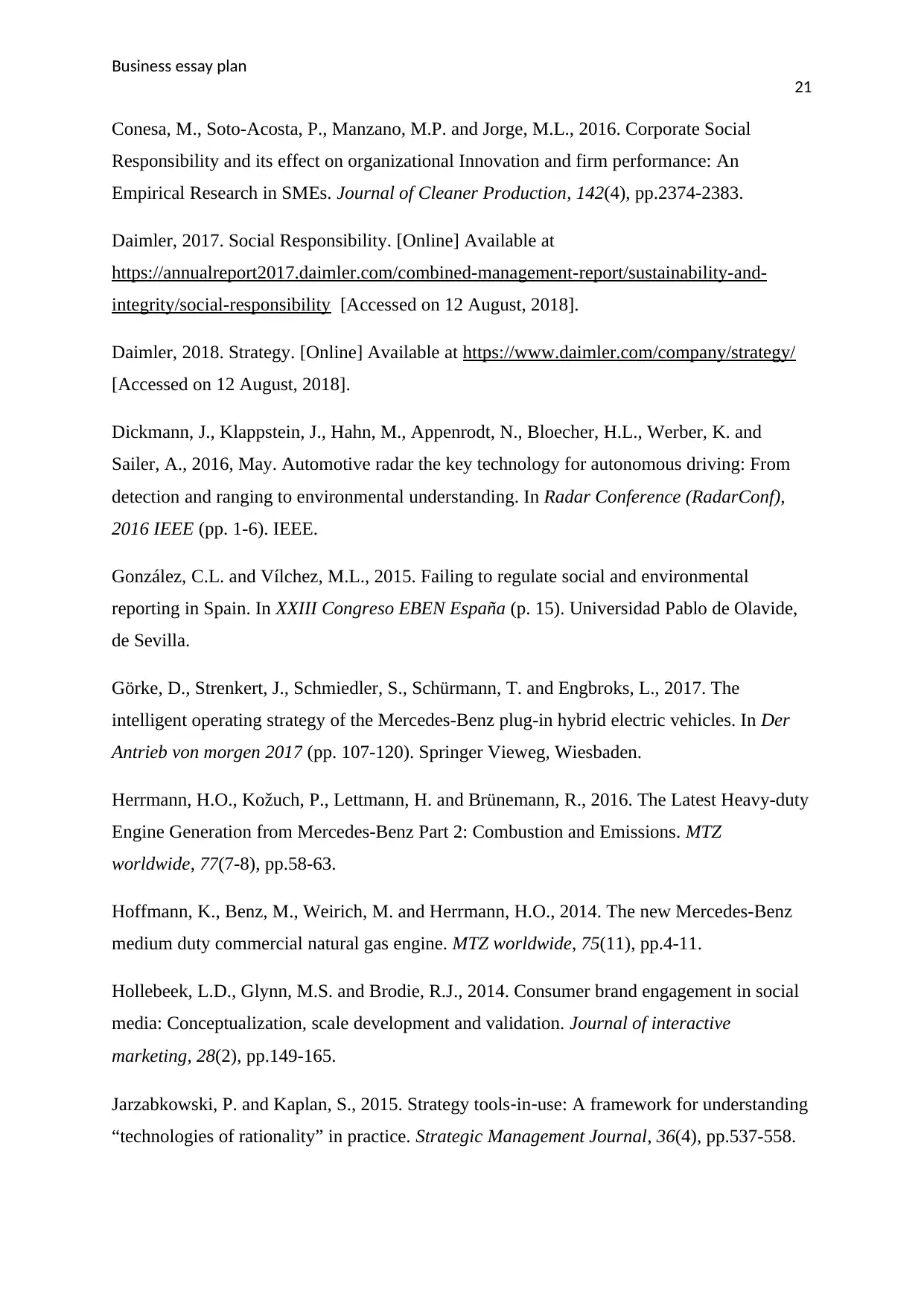
Business essay plan
21
Conesa, M., Soto-Acosta, P., Manzano, M.P. and Jorge, M.L., 2016. Corporate Social
Responsibility and its effect on organizational Innovation and firm performance: An
Empirical Research in SMEs. Journal of Cleaner Production, 142(4), pp.2374-2383.
Daimler, 2017. Social Responsibility. [Online] Available at
https://annualreport2017.daimler.com/combined-management-report/sustainability-and-
integrity/social-responsibility [Accessed on 12 August, 2018].
Daimler, 2018. Strategy. [Online] Available at https://www.daimler.com/company/strategy/
[Accessed on 12 August, 2018].
Dickmann, J., Klappstein, J., Hahn, M., Appenrodt, N., Bloecher, H.L., Werber, K. and
Sailer, A., 2016, May. Automotive radar the key technology for autonomous driving: From
detection and ranging to environmental understanding. In Radar Conference (RadarConf),
2016 IEEE (pp. 1-6). IEEE.
González, C.L. and Vílchez, M.L., 2015. Failing to regulate social and environmental
reporting in Spain. In XXIII Congreso EBEN España (p. 15). Universidad Pablo de Olavide,
de Sevilla.
Görke, D., Strenkert, J., Schmiedler, S., Schürmann, T. and Engbroks, L., 2017. The
intelligent operating strategy of the Mercedes-Benz plug-in hybrid electric vehicles. In Der
Antrieb von morgen 2017 (pp. 107-120). Springer Vieweg, Wiesbaden.
Herrmann, H.O., Kožuch, P., Lettmann, H. and Brünemann, R., 2016. The Latest Heavy-duty
Engine Generation from Mercedes-Benz Part 2: Combustion and Emissions. MTZ
worldwide, 77(7-8), pp.58-63.
Hoffmann, K., Benz, M., Weirich, M. and Herrmann, H.O., 2014. The new Mercedes-Benz
medium duty commercial natural gas engine. MTZ worldwide, 75(11), pp.4-11.
Hollebeek, L.D., Glynn, M.S. and Brodie, R.J., 2014. Consumer brand engagement in social
media: Conceptualization, scale development and validation. Journal of interactive
marketing, 28(2), pp.149-165.
Jarzabkowski, P. and Kaplan, S., 2015. Strategy tools‐in‐use: A framework for understanding
“technologies of rationality” in practice. Strategic Management Journal, 36(4), pp.537-558.
21
Conesa, M., Soto-Acosta, P., Manzano, M.P. and Jorge, M.L., 2016. Corporate Social
Responsibility and its effect on organizational Innovation and firm performance: An
Empirical Research in SMEs. Journal of Cleaner Production, 142(4), pp.2374-2383.
Daimler, 2017. Social Responsibility. [Online] Available at
https://annualreport2017.daimler.com/combined-management-report/sustainability-and-
integrity/social-responsibility [Accessed on 12 August, 2018].
Daimler, 2018. Strategy. [Online] Available at https://www.daimler.com/company/strategy/
[Accessed on 12 August, 2018].
Dickmann, J., Klappstein, J., Hahn, M., Appenrodt, N., Bloecher, H.L., Werber, K. and
Sailer, A., 2016, May. Automotive radar the key technology for autonomous driving: From
detection and ranging to environmental understanding. In Radar Conference (RadarConf),
2016 IEEE (pp. 1-6). IEEE.
González, C.L. and Vílchez, M.L., 2015. Failing to regulate social and environmental
reporting in Spain. In XXIII Congreso EBEN España (p. 15). Universidad Pablo de Olavide,
de Sevilla.
Görke, D., Strenkert, J., Schmiedler, S., Schürmann, T. and Engbroks, L., 2017. The
intelligent operating strategy of the Mercedes-Benz plug-in hybrid electric vehicles. In Der
Antrieb von morgen 2017 (pp. 107-120). Springer Vieweg, Wiesbaden.
Herrmann, H.O., Kožuch, P., Lettmann, H. and Brünemann, R., 2016. The Latest Heavy-duty
Engine Generation from Mercedes-Benz Part 2: Combustion and Emissions. MTZ
worldwide, 77(7-8), pp.58-63.
Hoffmann, K., Benz, M., Weirich, M. and Herrmann, H.O., 2014. The new Mercedes-Benz
medium duty commercial natural gas engine. MTZ worldwide, 75(11), pp.4-11.
Hollebeek, L.D., Glynn, M.S. and Brodie, R.J., 2014. Consumer brand engagement in social
media: Conceptualization, scale development and validation. Journal of interactive
marketing, 28(2), pp.149-165.
Jarzabkowski, P. and Kaplan, S., 2015. Strategy tools‐in‐use: A framework for understanding
“technologies of rationality” in practice. Strategic Management Journal, 36(4), pp.537-558.
Secure Best Marks with AI Grader
Need help grading? Try our AI Grader for instant feedback on your assignments.
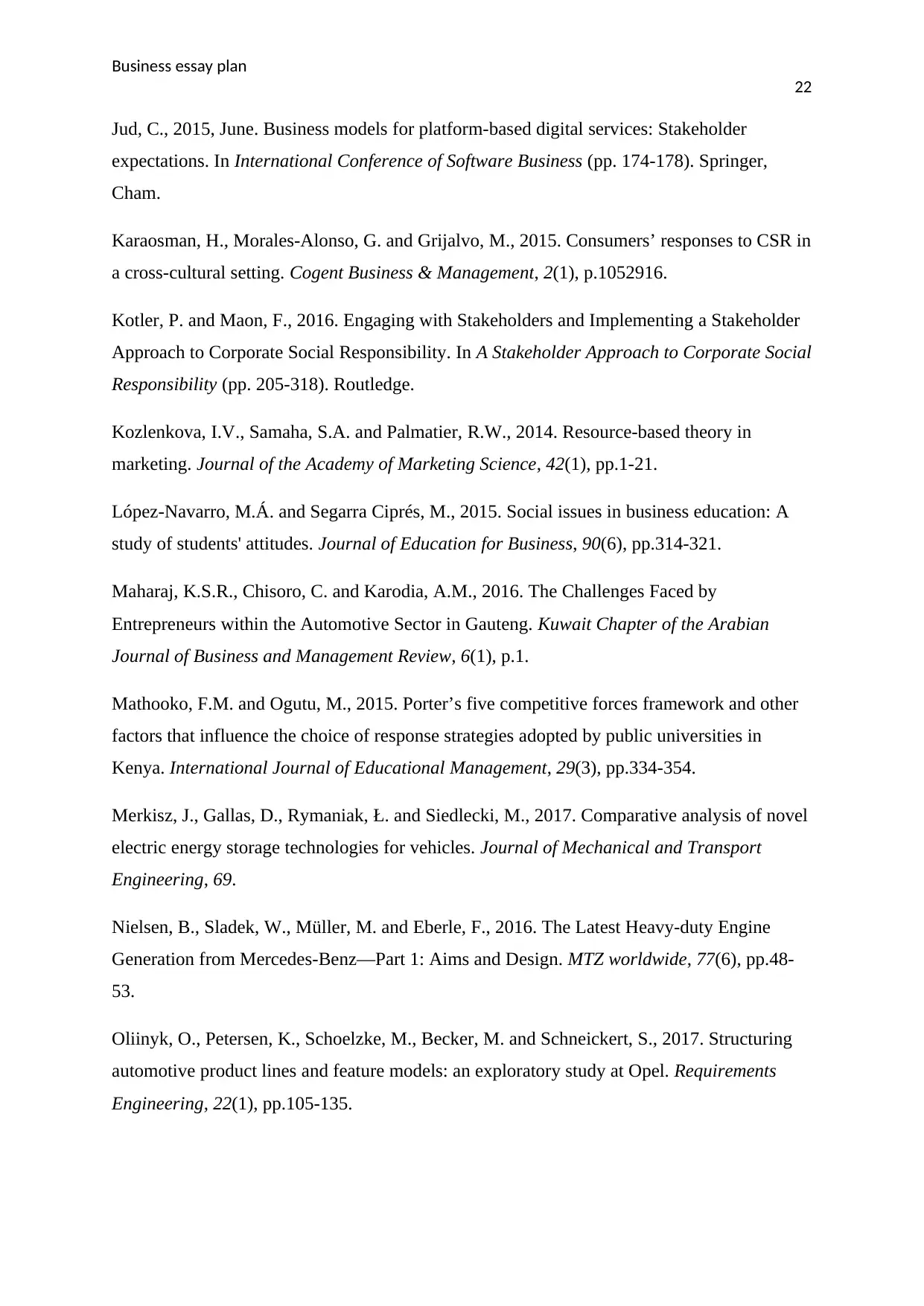
Business essay plan
22
Jud, C., 2015, June. Business models for platform-based digital services: Stakeholder
expectations. In International Conference of Software Business (pp. 174-178). Springer,
Cham.
Karaosman, H., Morales-Alonso, G. and Grijalvo, M., 2015. Consumers’ responses to CSR in
a cross-cultural setting. Cogent Business & Management, 2(1), p.1052916.
Kotler, P. and Maon, F., 2016. Engaging with Stakeholders and Implementing a Stakeholder
Approach to Corporate Social Responsibility. In A Stakeholder Approach to Corporate Social
Responsibility (pp. 205-318). Routledge.
Kozlenkova, I.V., Samaha, S.A. and Palmatier, R.W., 2014. Resource-based theory in
marketing. Journal of the Academy of Marketing Science, 42(1), pp.1-21.
López-Navarro, M.Á. and Segarra Ciprés, M., 2015. Social issues in business education: A
study of students' attitudes. Journal of Education for Business, 90(6), pp.314-321.
Maharaj, K.S.R., Chisoro, C. and Karodia, A.M., 2016. The Challenges Faced by
Entrepreneurs within the Automotive Sector in Gauteng. Kuwait Chapter of the Arabian
Journal of Business and Management Review, 6(1), p.1.
Mathooko, F.M. and Ogutu, M., 2015. Porter’s five competitive forces framework and other
factors that influence the choice of response strategies adopted by public universities in
Kenya. International Journal of Educational Management, 29(3), pp.334-354.
Merkisz, J., Gallas, D., Rymaniak, Ł. and Siedlecki, M., 2017. Comparative analysis of novel
electric energy storage technologies for vehicles. Journal of Mechanical and Transport
Engineering, 69.
Nielsen, B., Sladek, W., Müller, M. and Eberle, F., 2016. The Latest Heavy-duty Engine
Generation from Mercedes-Benz—Part 1: Aims and Design. MTZ worldwide, 77(6), pp.48-
53.
Oliinyk, O., Petersen, K., Schoelzke, M., Becker, M. and Schneickert, S., 2017. Structuring
automotive product lines and feature models: an exploratory study at Opel. Requirements
Engineering, 22(1), pp.105-135.
22
Jud, C., 2015, June. Business models for platform-based digital services: Stakeholder
expectations. In International Conference of Software Business (pp. 174-178). Springer,
Cham.
Karaosman, H., Morales-Alonso, G. and Grijalvo, M., 2015. Consumers’ responses to CSR in
a cross-cultural setting. Cogent Business & Management, 2(1), p.1052916.
Kotler, P. and Maon, F., 2016. Engaging with Stakeholders and Implementing a Stakeholder
Approach to Corporate Social Responsibility. In A Stakeholder Approach to Corporate Social
Responsibility (pp. 205-318). Routledge.
Kozlenkova, I.V., Samaha, S.A. and Palmatier, R.W., 2014. Resource-based theory in
marketing. Journal of the Academy of Marketing Science, 42(1), pp.1-21.
López-Navarro, M.Á. and Segarra Ciprés, M., 2015. Social issues in business education: A
study of students' attitudes. Journal of Education for Business, 90(6), pp.314-321.
Maharaj, K.S.R., Chisoro, C. and Karodia, A.M., 2016. The Challenges Faced by
Entrepreneurs within the Automotive Sector in Gauteng. Kuwait Chapter of the Arabian
Journal of Business and Management Review, 6(1), p.1.
Mathooko, F.M. and Ogutu, M., 2015. Porter’s five competitive forces framework and other
factors that influence the choice of response strategies adopted by public universities in
Kenya. International Journal of Educational Management, 29(3), pp.334-354.
Merkisz, J., Gallas, D., Rymaniak, Ł. and Siedlecki, M., 2017. Comparative analysis of novel
electric energy storage technologies for vehicles. Journal of Mechanical and Transport
Engineering, 69.
Nielsen, B., Sladek, W., Müller, M. and Eberle, F., 2016. The Latest Heavy-duty Engine
Generation from Mercedes-Benz—Part 1: Aims and Design. MTZ worldwide, 77(6), pp.48-
53.
Oliinyk, O., Petersen, K., Schoelzke, M., Becker, M. and Schneickert, S., 2017. Structuring
automotive product lines and feature models: an exploratory study at Opel. Requirements
Engineering, 22(1), pp.105-135.
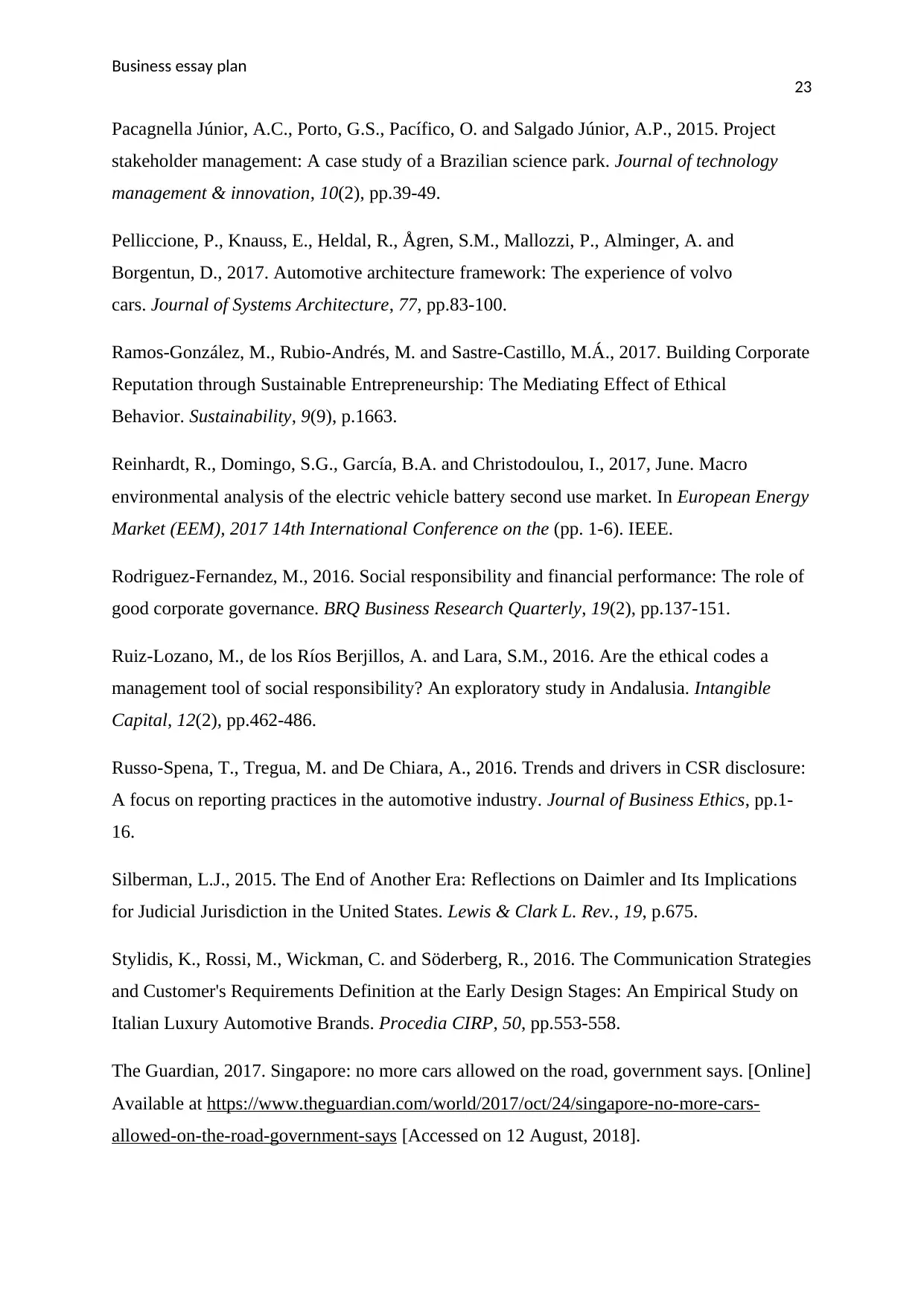
Business essay plan
23
Pacagnella Júnior, A.C., Porto, G.S., Pacífico, O. and Salgado Júnior, A.P., 2015. Project
stakeholder management: A case study of a Brazilian science park. Journal of technology
management & innovation, 10(2), pp.39-49.
Pelliccione, P., Knauss, E., Heldal, R., Ågren, S.M., Mallozzi, P., Alminger, A. and
Borgentun, D., 2017. Automotive architecture framework: The experience of volvo
cars. Journal of Systems Architecture, 77, pp.83-100.
Ramos-González, M., Rubio-Andrés, M. and Sastre-Castillo, M.Á., 2017. Building Corporate
Reputation through Sustainable Entrepreneurship: The Mediating Effect of Ethical
Behavior. Sustainability, 9(9), p.1663.
Reinhardt, R., Domingo, S.G., García, B.A. and Christodoulou, I., 2017, June. Macro
environmental analysis of the electric vehicle battery second use market. In European Energy
Market (EEM), 2017 14th International Conference on the (pp. 1-6). IEEE.
Rodriguez-Fernandez, M., 2016. Social responsibility and financial performance: The role of
good corporate governance. BRQ Business Research Quarterly, 19(2), pp.137-151.
Ruiz-Lozano, M., de los Ríos Berjillos, A. and Lara, S.M., 2016. Are the ethical codes a
management tool of social responsibility? An exploratory study in Andalusia. Intangible
Capital, 12(2), pp.462-486.
Russo-Spena, T., Tregua, M. and De Chiara, A., 2016. Trends and drivers in CSR disclosure:
A focus on reporting practices in the automotive industry. Journal of Business Ethics, pp.1-
16.
Silberman, L.J., 2015. The End of Another Era: Reflections on Daimler and Its Implications
for Judicial Jurisdiction in the United States. Lewis & Clark L. Rev., 19, p.675.
Stylidis, K., Rossi, M., Wickman, C. and Söderberg, R., 2016. The Communication Strategies
and Customer's Requirements Definition at the Early Design Stages: An Empirical Study on
Italian Luxury Automotive Brands. Procedia CIRP, 50, pp.553-558.
The Guardian, 2017. Singapore: no more cars allowed on the road, government says. [Online]
Available at https://www.theguardian.com/world/2017/oct/24/singapore-no-more-cars-
allowed-on-the-road-government-says [Accessed on 12 August, 2018].
23
Pacagnella Júnior, A.C., Porto, G.S., Pacífico, O. and Salgado Júnior, A.P., 2015. Project
stakeholder management: A case study of a Brazilian science park. Journal of technology
management & innovation, 10(2), pp.39-49.
Pelliccione, P., Knauss, E., Heldal, R., Ågren, S.M., Mallozzi, P., Alminger, A. and
Borgentun, D., 2017. Automotive architecture framework: The experience of volvo
cars. Journal of Systems Architecture, 77, pp.83-100.
Ramos-González, M., Rubio-Andrés, M. and Sastre-Castillo, M.Á., 2017. Building Corporate
Reputation through Sustainable Entrepreneurship: The Mediating Effect of Ethical
Behavior. Sustainability, 9(9), p.1663.
Reinhardt, R., Domingo, S.G., García, B.A. and Christodoulou, I., 2017, June. Macro
environmental analysis of the electric vehicle battery second use market. In European Energy
Market (EEM), 2017 14th International Conference on the (pp. 1-6). IEEE.
Rodriguez-Fernandez, M., 2016. Social responsibility and financial performance: The role of
good corporate governance. BRQ Business Research Quarterly, 19(2), pp.137-151.
Ruiz-Lozano, M., de los Ríos Berjillos, A. and Lara, S.M., 2016. Are the ethical codes a
management tool of social responsibility? An exploratory study in Andalusia. Intangible
Capital, 12(2), pp.462-486.
Russo-Spena, T., Tregua, M. and De Chiara, A., 2016. Trends and drivers in CSR disclosure:
A focus on reporting practices in the automotive industry. Journal of Business Ethics, pp.1-
16.
Silberman, L.J., 2015. The End of Another Era: Reflections on Daimler and Its Implications
for Judicial Jurisdiction in the United States. Lewis & Clark L. Rev., 19, p.675.
Stylidis, K., Rossi, M., Wickman, C. and Söderberg, R., 2016. The Communication Strategies
and Customer's Requirements Definition at the Early Design Stages: An Empirical Study on
Italian Luxury Automotive Brands. Procedia CIRP, 50, pp.553-558.
The Guardian, 2017. Singapore: no more cars allowed on the road, government says. [Online]
Available at https://www.theguardian.com/world/2017/oct/24/singapore-no-more-cars-
allowed-on-the-road-government-says [Accessed on 12 August, 2018].

Business essay plan
24
The Statista, 2018. Mercedes- Benz Cars: revenue from FY 2011 to FY 2017 (in billion
euros). [Online] Available at https://www.statista.com/statistics/346964/revenue-of-
mercedes-benz-cars/ [Accessed on 12 August, 2018].
Viveros, H., 2016. Examining stakeholders' perceptions of mining impacts and corporate
social responsibility. Corporate Social Responsibility and Environmental
Management, 23(1), pp.50-64.
24
The Statista, 2018. Mercedes- Benz Cars: revenue from FY 2011 to FY 2017 (in billion
euros). [Online] Available at https://www.statista.com/statistics/346964/revenue-of-
mercedes-benz-cars/ [Accessed on 12 August, 2018].
Viveros, H., 2016. Examining stakeholders' perceptions of mining impacts and corporate
social responsibility. Corporate Social Responsibility and Environmental
Management, 23(1), pp.50-64.
1 out of 25
Related Documents
Your All-in-One AI-Powered Toolkit for Academic Success.
+13062052269
info@desklib.com
Available 24*7 on WhatsApp / Email
![[object Object]](/_next/static/media/star-bottom.7253800d.svg)
Unlock your academic potential
© 2024 | Zucol Services PVT LTD | All rights reserved.





